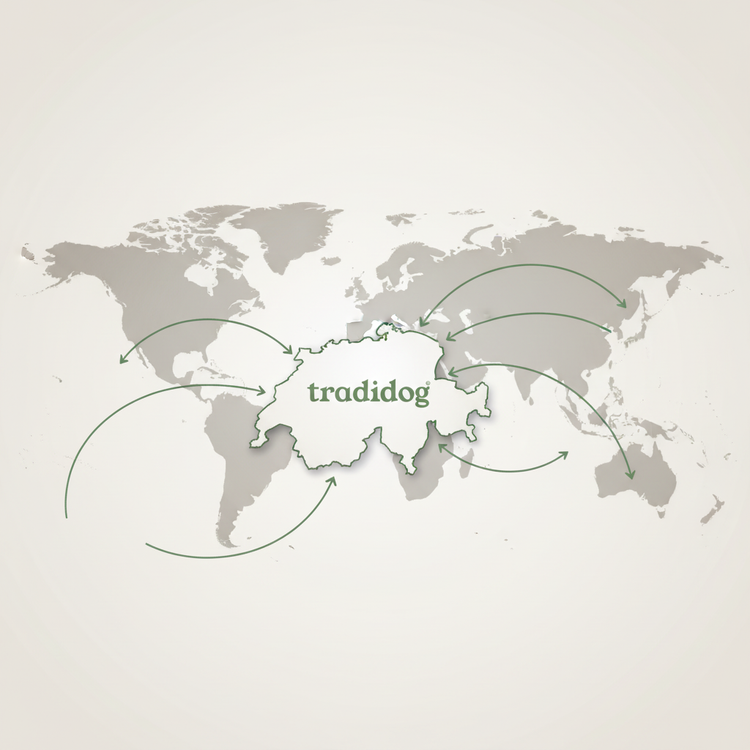Dog knowledge
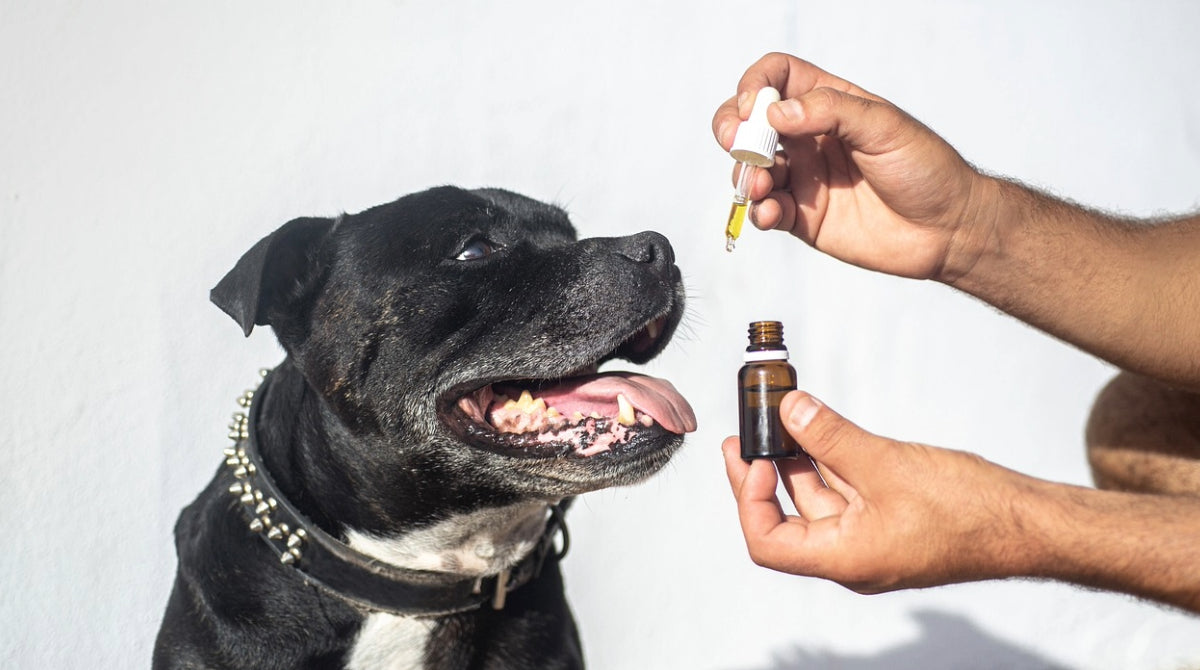
by Kim Rüegge
on Jan 15 2025
Fish oil is a popular ingredient in dog food because it can offer a variety of health benefits for your dog. It is particularly known for its high content of omega-3 fatty acids, such as EPA (eicosapentaenoic acid) and DHA (docosahexaenoic acid). These fatty acids play an important role in skin and coat health, the immune system, and joint health. They also promote brain function and the cardiovascular system. Fish oil is therefore often used in supplements for dogs with skin problems, joint pain, or cardiovascular disease.
In addition to the health benefits, however, there are also concerns about the quality and origin of fish oil. In particular, the pollution of oceans and possible overfishing are topics that are repeatedly raised. Dogs who are allergic to fish or who wish to avoid fish oil for ethical reasons are also looking for alternatives. This is where plant and other animal sources of omega-3 fatty acids come into play.
So what if you don't want to give your dog fish products and are looking for a more sustainable alternative? In this article, we'll discuss the function of fish oil and present alternatives that also provide valuable nutrients. We'll take a look at some products from Tradidog.ch and analyze which ones serve as alternatives to fish oil.
Here's a little teaser: You can get the best dog food supplements from us at tradidog !
What is fish oil and what is it used for in dogs?
Fish oil is a natural product extracted from the fatty tissue of fish. It contains a high concentration of omega-3 fatty acids, particularly EPA (eicosapentaenoic acid) and DHA (docosahexaenoic acid), which are of great importance to dogs. These fatty acids are essential for a variety of bodily functions:
Anti-inflammatory: Omega-3 fatty acids have anti-inflammatory effects and are therefore particularly helpful in inflammatory diseases such as arthritis.
Skin and coat health: Fish oil promotes a shiny, healthy coat and can relieve skin problems such as itching or dry skin.
Cardiovascular health: The fatty acids can help strengthen the heart and regulate blood lipid levels.
Brain and eye function: DHA in particular is important for the development and maintenance of brain and eye functions.
Many dog owners give their dogs fish oil either as a supplement or as part of their daily diet. But more and more owners are looking for alternatives, whether for health reasons, ethical considerations, or because they prefer a more sustainable option.
The role of fish oil in dog nutrition
Fish oil is primarily available in the form of liquid oil, capsules, or special treats. Dosage is important to avoid an excess of omega-3, as this can lead to undesirable side effects such as digestive problems or impaired immune function.
Many dog foods already contain fish oil, especially those for dogs with skin problems or for older dogs. However, there are also specialized supplements that contain additional omega-3 fatty acids.
Alternatives to fish oil for dogs
If you'd rather avoid fish oil, there are various plant and other animal sources of omega-3 fatty acids that can also benefit your dog. We take a look at the products from Tradidog.ch, which offer interesting alternatives to fish oil.
linseed oil
Flaxseed oil is an excellent plant-based source of omega-3 fatty acids, particularly alpha-linolenic acid (ALA). This fatty acid is converted into the more potent EPA and DHA in your dog's body, although to a lesser extent than fish oil. Therefore, flaxseed oil is a good choice if you're looking for a plant-based alternative.
Benefits of linseed oil:
Rich in omega-3 fatty acids (ALA).
Promotes skin health and has anti-inflammatory properties.
Easy addition to food (in liquid form).
Algae oil
Algal oil is an excellent source of DHA and EPA, available directly in a form your dog's body can use. It's a sustainable and ethical alternative to fish oil because it doesn't require fishing. Algal oil is derived from microalgae and has the advantage of being rich in antioxidants that protect your dog's cells from harmful free radicals.
Benefits of algae oil:
Direct source of DHA and EPA.
Sustainable and free from fishing.
Supports skin, coat and brain function.
Chia seeds
Chia seeds are another plant-based source of omega-3 fatty acids, particularly in the form of ALA. You can easily mix chia seeds into your dog's food. However, be aware that the conversion to EPA and DHA in the dog's body is less efficient than with fish oil.
Benefits of chia seeds:
Rich in ALA, a plant source of Omega-3.
Promotes skin and coat health.
Easy to use and available in many forms (whole, ground or in oil form).
Hemp oil
Hemp oil is another plant-based source of omega-3 fatty acids and also has anti-inflammatory properties. It also contains a good balance of omega-3 and omega-6 fatty acids, which is important for dogs to control inflammation and promote overall well-being.
Benefits of hemp oil:
Rich in omega-3 and omega-6 fatty acids.
Promotes general health and has anti-inflammatory properties.
A plant-based alternative to fish oil
Specific product recommendations
Tradidog Classic
This supplement contains high-quality flaxseed, a natural source of omega-3 fatty acids. Flaxseed is rich in fiber and mucilage, which aid digestion and support intestinal health. It also contains essential fatty acids that are important for your dog's overall health.
Tradidog BOOST
This product offers comprehensive support for your dog's health. It contains flaxseed, a natural source of omega-3 fatty acids. Flaxseed is rich in fiber and mucilage, which aid digestion and support intestinal health. It also contains essential fatty acids that are important for your dog's overall health.
Tradidog SENSITIVE
This supplement is specially formulated for sensitive dogs and contains flaxseed, a natural source of omega-3 fatty acids. Flaxseed is rich in fiber and mucilage, which aid digestion and support intestinal health. It also contains essential fatty acids, which are important for your dog's overall health.
Tradidog SENIOR
This product is specially formulated for senior dogs and contains flaxseed, a natural source of omega-3 fatty acids. Flaxseed is rich in fiber and mucilage, which aid digestion and support intestinal health. It also contains essential fatty acids that are important for your dog's overall health.
Conclusion
Fish oil is undoubtedly a valuable source of omega-3 fatty acids, but there are many alternatives that can benefit your dog just as much. Plant-based oils such as flaxseed oil, hemp oil, and algal oil offer sustainable and ethical options to meet your dog's nutritional needs. When considering a fish oil alternative, however, always pay attention to the quality of the product and the correct dosage to optimally support your dog's health.
At tradidog, we promise you the highest quality in our products. So, please visit our online shop and let us convince you.
Tradidog motto: If you want to walk your dog morning, noon, and night, then definitely buy Tradidog products!
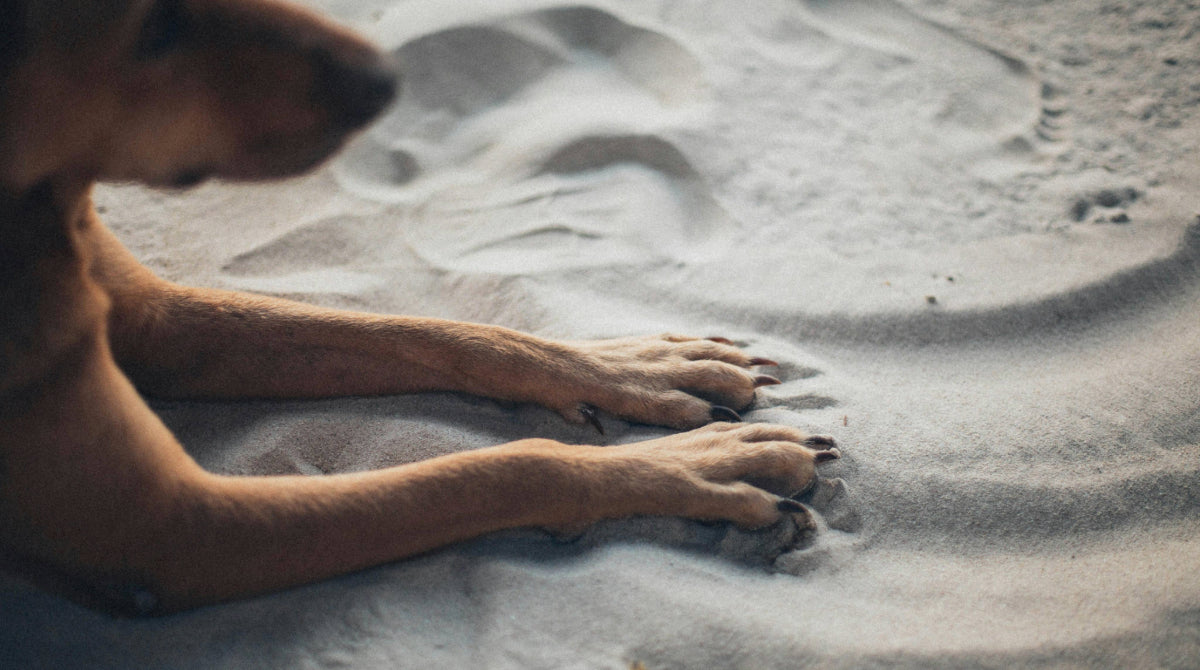
by Kim Rüegge
on Jan 12 2025
Your dog's paws are true wonders of nature. They carry him over hill and dale, protect his joints, provide grip on smooth surfaces, and help him explore the world. At the same time, they are subjected to extreme stress and require your attention and care. In this article, we delve deep into the world of dog paws, from their anatomy and functions to tips for proper care.
Structure and functions of dog paws
A dog's paws consist of different parts that are perfectly coordinated to perform a variety of tasks:
Pads – The foundation of the paws
The pads are thick, elastic cushions made of a combination of fat and connective tissue. They act as shock absorbers and protect your dog's bones and joints from impact.
A rough surface provides additional grip on various surfaces, whether smooth tiles, slippery asphalt or muddy meadows.
Studies have shown that the bales have a high resilience and can even adapt to different environmental influences.
Claws – Practical tools
The claws help your dog to support himself, dig, and hold objects.
They are particularly important on slippery surfaces as they provide additional grip.
However, claws that are too long can lead to poor posture or even pain.
Interdigital skin – flexibility and protection
The skin between the toes provides mobility and flexibility, allowing your dog to move safely over uneven or difficult terrain.
Temperature regulation
Did you know that dog paws have sweat glands? These play a role in temperature regulation and fighting off bacteria.
Reactions to environmental influences
Heat in summer
Hot asphalt is one of the biggest dangers for dog paws in the summer. Temperatures above 50 degrees Celsius can burn your dog's pads.
A simple back-of-the-hand test: Place your hand on the floor for a few seconds. If it's too hot for you, it'll be uncomfortable for your dog, too.
Alternatively, special paw shoes can provide relief.
Cold and road salt in winter
Cold temperatures dry out the pads, which can lead to cracks and pain. Snow and ice can clump between the toes and cause pressure sores.
Road salt is another problem because it irritates sensitive skin and, in the worst case, is toxic if licked off.
Detection of injuries and problems
Warning signs of paw problems
Limping or avoiding contact with the ground
Excessive licking or biting of a particular paw
Visible redness, swelling or open wounds
First aid for injuries
Small cracks or wounds : Clean the affected area with clean water and disinfect it carefully.
Splinters or foreign bodies : Carefully remove these with tweezers and then apply paw cream.
Deep cuts or persistent swelling : Seek immediate veterinary attention.
Paw care – tips and tricks for healthy paws
Regular inspection
Check your dog's paws after every walk. Look for small stones, splinters, or dirt that might be stuck between the toes.
Claw care
Trim your dog's claws regularly to prevent poor posture. A good guideline: The claws should not touch the ground when your dog is standing.
Use paw balm
Special paw balms or creams keep the pads supple and protect them from environmental influences. Natural products containing beeswax or coconut oil are especially recommended.
Cleaning after the walk
After walks in winter, you should clean the paws with lukewarm water to remove road salt and dirt.
Dry the paws thoroughly, especially between the toes, to avoid skin irritation.
Paw protection in extreme conditions
Dog shoes can provide effective protection in extreme situations, such as hiking on sharp surfaces or in icy temperatures.
Products for paw care
Recommended products
Paw balm : Natural versions with shea butter, beeswax or calendula extract.
Paw shoes : Water-repellent and breathable, ideal for extreme conditions.
Claw clippers : Special scissors or grinders for claw care.
Home remedies for care
Coconut oil : Has antibacterial properties and moisturizes.
Chamomile baths : Help with irritated skin and minor inflammations.
Conclusion
Your dog's paws are an essential tool for his well-being and vitality. They carry him through a variety of situations – from exciting walks to long games to challenging hikes. But precisely because they are so versatile, they require your special attention.
Regular paw care not only ensures your dog stays pain-free and mobile, but can also prevent serious injuries or illnesses. From checking after every walk to using special care products, you can do a lot to maintain your dog's health. Simple measures like cleaning their paws, properly trimming their nails, and applying paw balm also play a major role.
The environment also has a significant impact on your dog's paws. Whether it's hot asphalt in the summer, icy roads in the winter, or sharp surfaces – with the right preparation and protective clothing, you can help your dog safely overcome these challenges. Remember: prevention is better than cure.
A dog with healthy paws is a happy dog. By taking the time to care for their paws, you're not only contributing to their health but also to a deeper bond between you and your four-legged friend. Together, you'll enjoy every adventure without worry—step by step.
You can find more information in our second blog post on dog paws . So feel free to check it out.
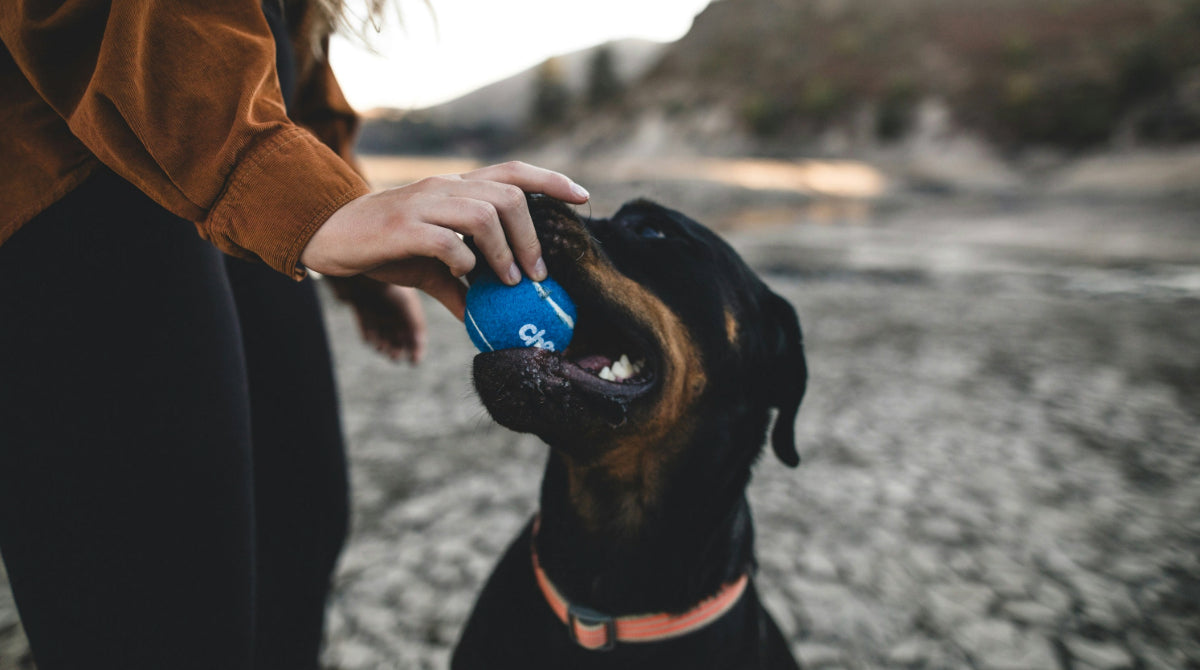
by Kim Rüegge
on Jan 09 2025
Dogs are loyal companions and often a reflection of our own feelings. But just like humans, dogs can also suffer from stress. Stress in dogs is an often underestimated problem that can severely impact both your four-legged friend's well-being and your relationship. It's important to understand that stress isn't just a short-term reaction to an unfamiliar situation; if it becomes chronic, it can have serious health consequences. In this article, you'll learn what can trigger stress in dogs, how to recognize the signs, and what practical measures there are to relieve your dog's stress. We'll also take a look at the treatment options and scientific findings available on this topic to ensure you're fully informed.
Did you know that a 2019 Swedish study found that dogs' stress levels often correlate closely with those of their owners? This shows how important your own behavior is for your dog. Let's delve into this important topic together to understand and support your four-legged friend.
Why do dogs get stressed?
Stress is the body's natural response to potentially dangerous or challenging situations. In dogs, short-term stress can help them respond to threats, but long-term stress can be detrimental to their health. Chronic stress can lead to behavioral problems, a weakened immune system, and even physical problems such as gastrointestinal issues.
Studies show that dogs who are stressed for extended periods have an increased risk of heart disease. A 2019 study by Linköping University in Sweden even found that dogs' stress levels are closely correlated with those of their owners. So, your own well-being has a direct impact on your four-legged friend.
How do you recognize stress in your dog?
The signs of stress in dogs can be subtle, but with awareness and knowledge, you can spot them early. Here are some of the most common symptoms:
Body language: A tucked tail, ears laid back, panting without effort or eyes wide open (“whale eye”).
Behavioral changes: restlessness, increased barking, hiding, aggression or sudden fearfulness.
Physical symptoms: diarrhea, vomiting, loss of appetite, or increased paw licking.
Displacement activities: Yawning, shaking, or scratching in situations that give no reason to do so.
If you notice one or more of these signs, it's worth identifying the trigger.
Causes of stress in dogs
Stress can be triggered by a variety of factors, including:
Changes in everyday life: moving, new family members or changed routines.
Environmental stimuli: noise, too many people or new places.
Social pressure: conflicts with other dogs or excessive expectations from the owner.
Physical complaints: pain or illness.
Lack of workload: Both mental under-stimulation and excessive demands can trigger stress.
How can you help your dog? Tips and tricks
There are various ways to combat stress in dogs:
Identify and avoid stress triggers: Keep a journal to identify patterns.
Create places to retreat: A safe place like a den or a basket will help your dog relax.
Maintain a routine: Dogs love predictability. Keep feeding, walking, and sleeping times as consistent as possible.
Mental stimulation: Intelligence toys and search games can help keep your dog's mind busy.
Send calming signals: Gentle stroking, quiet words and targeted breathing exercises can give your dog security.
Essential oils: Lavender oil can have a calming effect in large quantities. Caution: Not all oils are suitable for dogs.
Medications and therapies
In severe cases, when other measures are not sufficient, the following options are available:
Medication: There are anti-anxiety and sedative medications for dogs. However, these should always be used in consultation with a veterinarian.
Behavioral therapy: A dog trainer or behavior specialist can help specifically address stress-inducing behavior.
Physiotherapy and massages: These can reduce muscular tension.
Useful facts about stress in dogs
Hormones: Stress causes the release of the hormone cortisol. Long-term elevated cortisol levels can weaken the immune system.
Music therapy: Classical music can have a calming effect. There's even music specifically designed for dogs.
Synchronization: Dogs often adapt to their owner's stress level. Your own calmness also helps your dog.
Long-term solution: Stress reduction is a process. Patience and consistency pay off.
Conclusion
Stress in dogs is a serious issue that shouldn't be ignored. Your dog trusts you to understand their needs and support them in difficult situations. By identifying stress triggers, maintaining a balanced routine, and seeking professional help if necessary, you can help your dog lead a relaxed and happy life.
Remember that stress management doesn't happen overnight. It requires time, patience, and sensitivity. But the reward is a deeper bond and a healthier, happier life for your four-legged friend. Together, you can overcome challenges and build a strong partnership based on trust and understanding.
Tradidog motto: Enjoy, sleep, eat – don’t let yourself or your dog get stressed.
And now, finally, an important and exciting video that examines the topic in more detail.
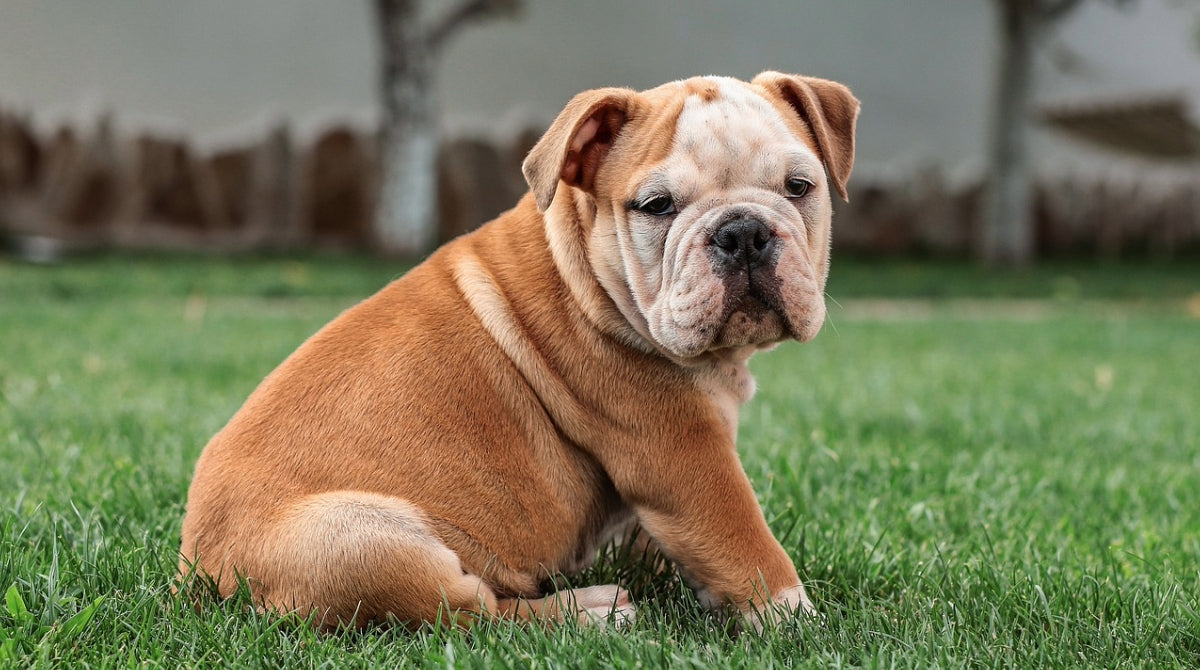
by Kim Rüegge
on Jan 06 2025
"A small dog with a big heart: The French Bulldog"
You're sitting in a café in Paris, next to a small dog with large, pointy ears and a faithful gaze that enchants everyone. The French Bulldog—charming, playful, and full of personality—is a loyal companion and one of the most popular dog breeds in the world. But what makes these dogs so special? And why are they called "French" even though they originally come from England? Let's delve into the world of the French Bulldog together.
The origin: From England to France – an international success story
The history of the French Bulldog begins in 19th-century England. Originally, small bulldogs were bred as companions for English workers, especially lacemakers, who emigrated to France during the industrial revolution. They brought their small dogs with them, which quickly became popular in France.
In France, breeding began with a focus on the breed's endearing expression and characteristic "bat ears." Thus, the French Bulldog as we know it today was born. Its popularity grew rapidly, and it soon became a favorite of Parisian bohemians, artists, and writers.
Appearance: A distinctive look
The French Bulldog is a small, compact breed with a distinctive appearance:
Size : 25–35 cm shoulder height
Weight : 8–14 kg (females usually lighter than males)
Life expectancy : 10–12 years
Coat : Short, smooth, shiny and easy to care for, in colors such as brindle, fawn, white or with markings.
Their distinctive features are their large, upright ears, reminiscent of bats, and their short, broad snout, which gives them a unique expression. Despite their muscular build, they appear friendly and approachable—a perfect reflection of their nature.
Character: A Heart of Gold
The French Bulldog is known for its friendly, loving, and affectionate nature. Here are some highlights:
Sociability : These dogs love company—both from humans and other animals. They feel just as comfortable in a family as in a single household.
Playfulness : Their playful nature makes them wonderful companions, especially for children.
Serenity : They are not great athletes, but enjoy leisurely walks and cuddling on the sofa.
Willfulness : Despite their gentleness, they have a certain stubbornness that can be overcome with patience and humor.
Health: Special needs of a special dog
The French Bulldog is a brachycephalic (short-nosed) breed, which presents some health challenges:
Breathing problems : Due to their short snout, breathing difficulties can occur, especially in hot weather or during exertion.
Sensitive skin : The skin folds on the face must be cleaned regularly to avoid infections.
Back problems : Their compact bodies can be prone to spinal problems.
Care tips:
Keep an eye on the weight to relieve pressure on your joints and respiratory system.
Brush her coat regularly to remove loose hair.
Avoid long walks in hot weather and plan regular breaks.
Important facts at a glance
Suitable for: City apartments, as they require little space and movement.
Special features: Excellent companion dogs for elderly people or families with children.
Cost: French Bulldogs can be expensive, depending on the breeder and origin, between 2,000 and 4,000 CHF.
Not suitable for: People looking for a dog for intensive sporting activities.
French Bulldogs as family members
French Bulldogs are more than just pets—they are true family members. Their loving and affectionate nature makes them ideal companions. They are attentive, playful, and have the unique ability to make their owners laugh, even on gloomy days.
Conclusion
The French Bulldog is far more than just a trendy dog—it's a breed that captivates people all over the world with its unique personality, charming looks, and loving nature. It combines qualities that make it a perfect family member: its affectionate nature, its playful personality, and its ability to adapt to both active and more relaxed lifestyles.
If you're looking for a dog that enjoys spending time with you, will be loyal to you, and will always make you laugh with their clever and sometimes quirky personality, the French Bulldog is a fantastic choice. They may be small, but they have a big heart and know how to make their owners happy.
However, their charming appearance also brings with it responsibility. The French Bulldog is a breed that requires special attention, especially when it comes to their health. Respiratory problems, skin care, and proper nutrition are just some of the things you need to consider on a daily basis. At the same time, they will reward your care with unconditional love, a deep bond, and countless happy moments together.
For people willing to accommodate the breed's unique needs, the French Bulldog will be more than just a pet, but a loyal friend who will accompany you through life. Whether as a couch potato, playmate, or simply a quiet listener when you need someone, the French Bulldog will never disappoint.
By choosing this breed, you're investing in a lifetime of joy, laughter, and unconditional affection. The French Bulldog will show you what it means to experience true friendship in its purest form.
Finally, we recommend watching the following video on the topic. Enjoy!
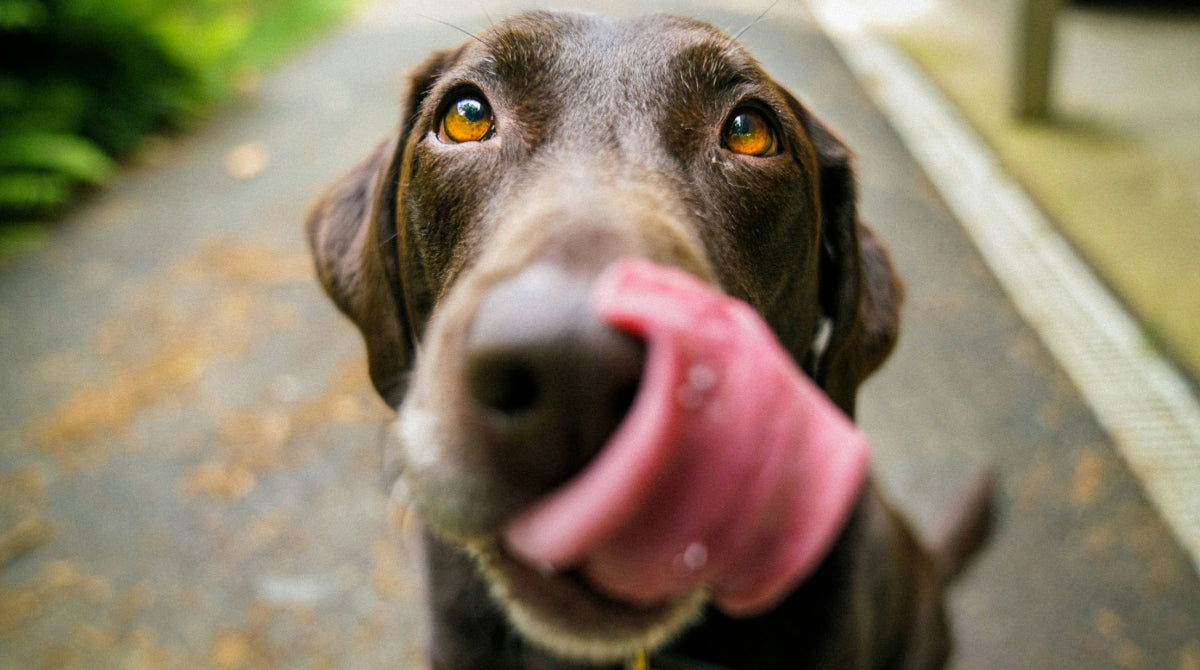
by Kim Rüegge
on Jan 03 2025
Who hasn't experienced this from their time living in a shared apartment? Time is short, the budget is small, and the fridge is empty. So, off you go to the nearby supermarket. The shopping basket is quickly filled. Once again, it's pasta with pesto. And because the quote "Eating is a necessity, eating together is a pleasure – even with our dogs" perfectly expresses it, you wonder if dogs can also join in the pasta festivities. The thought of letting your four-legged friend share in your enjoyment is tempting. But how healthy is pasta for dogs, really? In this blog post, we'll explain and give you practical tips on dog nutrition.
Pasta and dogs: A basic knowledge
Pasta is one of the most popular foods worldwide and consists primarily of wheat flour, water, and sometimes eggs. But what does this mean for your dog?
Carbohydrates as an energy source : Pasta contains mainly carbohydrates, which can provide your dog with short-term energy.
Lack of essential nutrients : Compared to meat or special dog foods, pasta is low in nutrients and does not provide the vitamins or minerals your dog needs.
Excess calories : Too much pasta can lead to obesity, especially in less active dogs.
The good news: Dogs can eat cooked pasta occasionally and in small quantities, as long as it is unseasoned and natural.
Suitable types of pasta for dogs
Not every type of pasta is equally suitable for your dog. Here's an overview of the best options:
Suitable:
Wheat noodles : Classic noodles made from wheat flour are easy to digest and unproblematic in small quantities.
Whole wheat pasta : Contains more fiber, which can aid digestion, but be careful: some dogs react to it with flatulence.
Gluten-free pasta : Rice or corn pasta are ideal for dogs with gluten intolerance.
Egg noodles : The egg content provides additional protein, but should still only be fed rarely.
Not suitable:
Instant noodles : They often contain additives that are harmful to dogs.
Pasta with fillings (e.g. ravioli): The fillings may contain spices, onions or garlic, which are toxic to dogs.
Preparation tips: How to make pasta suitable for dogs
To ensure your dog can enjoy pasta safely, there are some important rules:
No spices or salt: Avoid salt, garlic, onions, or other spices. They are difficult for dogs to digest or even toxic.
Cooked well: The pasta should be soft so that your dog's stomach can process it more easily.
No sauces: Creamy or tomato-based sauces often contain sugar, salt or spices that are unsuitable for dogs.
A simple recipe:
Cook 2-3 tablespoons of plain noodles (e.g. rice noodles) without salt or spices.
Add some cooked chicken or turkey and steamed vegetables (like carrots or zucchini).
Let the meal cool before serving it to your dog.
Risks and what you should pay attention to
Although noodles themselves are not poisonous, there are a few things you should keep in mind:
Avoid calorie bombs : Pasta contains a lot of calories but few important nutrients. Too much can lead to obesity.
Recognizing allergies : Some dogs react to gluten or wheat with skin rashes or digestive problems. Monitor your dog closely after feeding.
Raw pasta : Never feed raw pasta. It's difficult to digest and, in the worst case, can swell in the stomach or intestines.
If your dog shows vomiting, diarrhea, or other symptoms after eating pasta, contact your veterinarian.
Healthy alternatives to pasta
There are many foods that your dog might enjoy as much as pasta and are healthier at the same time:
Rice : Particularly easy to digest and an ideal side dish if your dog has stomach problems.
Potatoes : Cooked, unseasoned potatoes provide energy and vitamins.
Vegetables : Carrots, zucchini, sweet potatoes or pumpkin are healthy and delicious options.
Quinoa : A protein-rich alternative that also contains many vitamins and minerals.
Other snacks for in between:
Cooked chicken strips
Unsalted rice crackers
Apple pieces (without cores)
Conclusion
Yes, your dog can occasionally eat cooked, unseasoned pasta. However, it should never be their primary source of food, as it doesn't provide all the necessary nutrients. Consider serving pasta as a small treat or as a side dish to a balanced meal. If you're unsure whether your dog can tolerate a particular food, consult your veterinarian.

by Kim Rüegge
on Jan 01 2025
"The greatest gift is a sleeping dog – unless he snores like a lumberjack."
Who among us hasn't experienced this? You're lying in bed at night, trying to relax, and suddenly you hear an unmistakable sound next to you: your partner is snoring! While some find this noise cute or even soothing, for others it can cause sleepless nights. Even worse when your dog snores too! A phenomenon that Martin Rütter humorously explores in his video.
But why does this happen to dogs, and what can you do about it? Let's delve into the world of animal snoring together.
Why do dogs snore?
Snoring is caused by a blockage or narrowing of the airways. In dogs, there are several reasons why this can happen:
Anatomy: Dogs with short snouts, such as pugs and bulldogs, often have narrow nasal passages and an elongated soft palate due to their breeding. This makes them prone to snoring.
Obesity: Extra weight can also put strain on the respiratory system. Fatty tissue around the neck and chest can impair breathing.
Allergies: Pollen, dust, or other irritants can cause your dog's airways to swell.
Sleeping position: Sometimes it is simply a particularly relaxed position that partially blocks the airways.
Health problems: Polyps, infections or even serious illnesses such as tracheal collapse can be behind snoring.
Is your dog's snoring dangerous?
Not all snoring is cause for concern. However, there are signs that suggest you should have the problem examined more closely:
Irregular snoring: Does snoring occur suddenly without your dog having snored before?
Other symptoms: Does your dog have difficulty breathing, cough often, or seem exhausted?
Heavy breathing: Do you hear a whistling or hissing sound while breathing?
If you're unsure, a visit to your veterinarian is recommended. They can determine whether treatment is necessary.
Tips and tricks: What to do if your dog snores?
Weight control: If your dog is overweight, even a slight weight loss can work wonders. A healthy diet and regular exercise are key.
Optimize your sleeping area: Provide a comfortable dog bed. Some dogs snore less when they sleep slightly elevated or on their side.
Improve air quality: Use a humidifier or keep the sleeping area free of dust. Fresh air helps your dog breathe better.
Treating Allergies: If your dog suffers from allergies, talk to your veterinarian about appropriate treatments.
Surgery for anatomical problems: In severe cases, surgery may be necessary to widen the airways. This particularly affects short-nosed breeds.
Keep calm: If your dog only snores occasionally and is otherwise healthy, there's no need to worry. Instead, enjoy the gentle "sawing" of your canine companion.
Exciting facts about snoring
Remember the following for your next team dinner or pub quiz:
Not only dogs snore: cats, horses and even dolphins can snore too!
Short-nosed breeds snore more often: But Labradors and dachshunds can also become snorers.
Pure relaxation: Some dogs only snore when they are sleeping particularly deeply and relaxed.
Conclusion
A snoring dog can be both annoying and endearing. Often, it's due to harmless reasons, such as sleeping position or a slight constriction of the airway. In some cases, however, it can indicate health problems. With a few simple measures, you can help your dog and yourself have a more restful night. However, if snoring occurs suddenly or is accompanied by other symptoms, don't hesitate to consult a veterinarian.
At the end of the day, a snoring dog may be loud—but it also shows you how comfortable it is with you. And that's the most important thing, right?
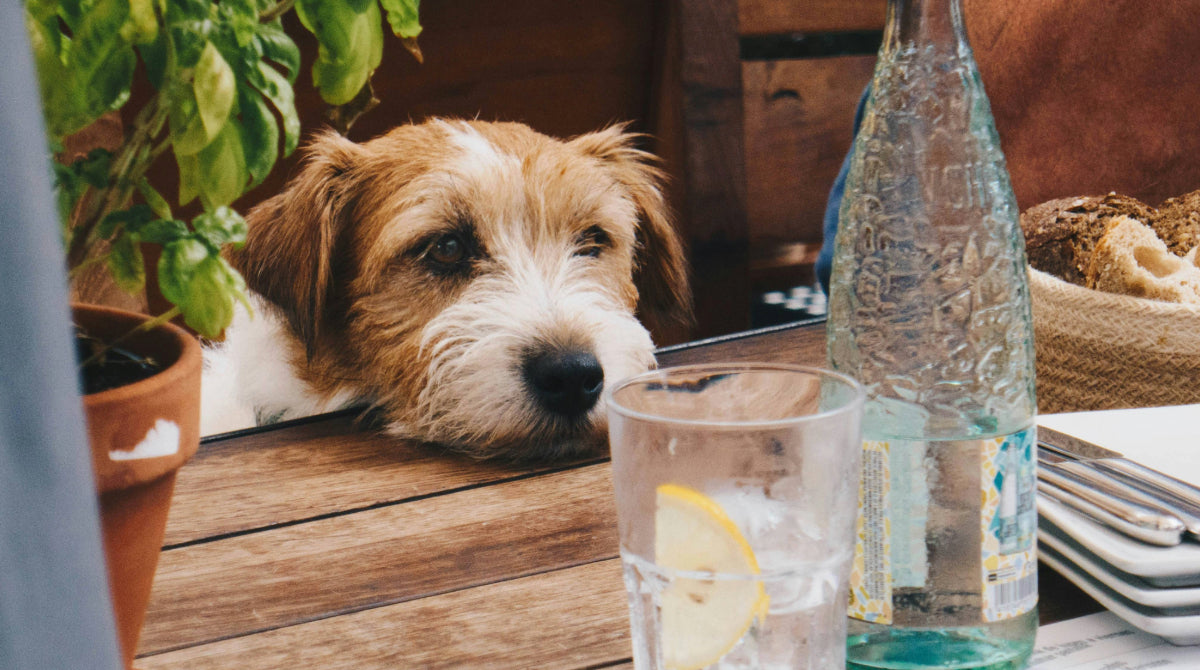
by Kim Rüegge
on Dec 29 2024
Imagine you're out on a hot summer day. Your dog is happily running beside you, the sun is beating down on you, and you finally reach a fountain. You fill the bowl, but your dog just takes a quick sniff and moves on. You worry: Why isn't he drinking? And how dangerous is that?
It's not uncommon for dogs to not drink enough. But the consequences can be serious, from dehydration to organ problems. In this article, you'll learn why your dog might not be drinking enough, how you can help, and which tricks really work.
Why is drinking enough so important?
Water fulfills many vital functions in your dog's body. It regulates body temperature, aids digestion, and ensures that all organs function properly. A lack of fluid can result in fatigue, digestive problems, and, in the worst case, life-threatening conditions such as heatstroke.
A simple rule of thumb: A dog needs about 50 ml of water per kilogram of body weight per day. So, a 20 kg dog should drink about 1 liter of water. But what if it doesn't?
Causes: Why doesn’t your dog drink enough?
There are many reasons why a dog drinks little or not at all:
No thirst: In cooler weather or when there is little exercise, the dog simply does not have a great need for fluids.
Unclean water: Dogs are often picky when it comes to the taste or cleanliness of the water.
Stress or anxiety: Changes in everyday life, such as moving or new surroundings, can influence drinking behavior.
Health problems: Pain in the mouth, kidney disease or other illnesses can reduce the feeling of thirst.
Unfamiliar bowl: A slippery or unpleasant-smelling bowl can also be a deterrent.
Tips: How to encourage your dog to drink
Of course, you always have to figure out how to properly interact with your four-legged friend yourself. Nevertheless, we'd like to share some tips to encourage your dog to drink:
Offer fresh water : Change the water regularly. Some dogs prefer it cold, others room temperature.
Choose the right bowl : Stainless steel or ceramic bowls are often better than plastic because they do not give off unpleasant odors.
Change location : Provide water in different places around the house so your dog always has access.
Tasty water : Add a few drops of unseasoned broth (e.g. chicken broth without salt) to the water to make it more attractive.
Include exercise : After an active game, thirst increases.
Integrate toys : There are special water dispenser toys that motivate the dog to drink.
Absorb fluids through food
If your dog does not drink enough despite all your efforts, you can increase the fluid intake through food:
Wet food instead of dry food : Wet food contains up to 80% water.
Add water to dry food : Soaking can work wonders, especially for older dogs.
Watermelon & Cucumber : These contain a lot of water and are a great refreshment in summer (in moderation and without seeds).
Homemade broth : Make sure it is prepared unsalted and without onions or garlic.
A quick but important reminder: When it comes to nutritional supplements, we at Tradidog are your most important partner. Feel free to check out our products and do something good for your dog!
Conclusion
Your dog depends on you for his health. Healthy drinking habits contribute significantly to his well-being. Often, simple tricks like making the water more palatable or choosing a different bowl are enough to solve the problem. You can also do a lot through food to ensure your dog gets enough fluids.
But it's equally important to remain patient and observe your dog. Every dog has unique preferences and needs. Sometimes it takes time for a new strategy to take effect. It's important to focus on long-term health. If you're unsure or suspect health problems, don't hesitate to seek veterinary advice.
With the right adjustments and a little patience, you can ensure your dog stays healthy, happy, and well-hydrated. Because a happy, healthy dog is your greatest joy, too! 🐶✨
Below is a video on the topic and our well-known Tradidog motto. We raise our mugs and bowls and say cheers!
Tradidog motto: Turn the little stinker into a big drinker!
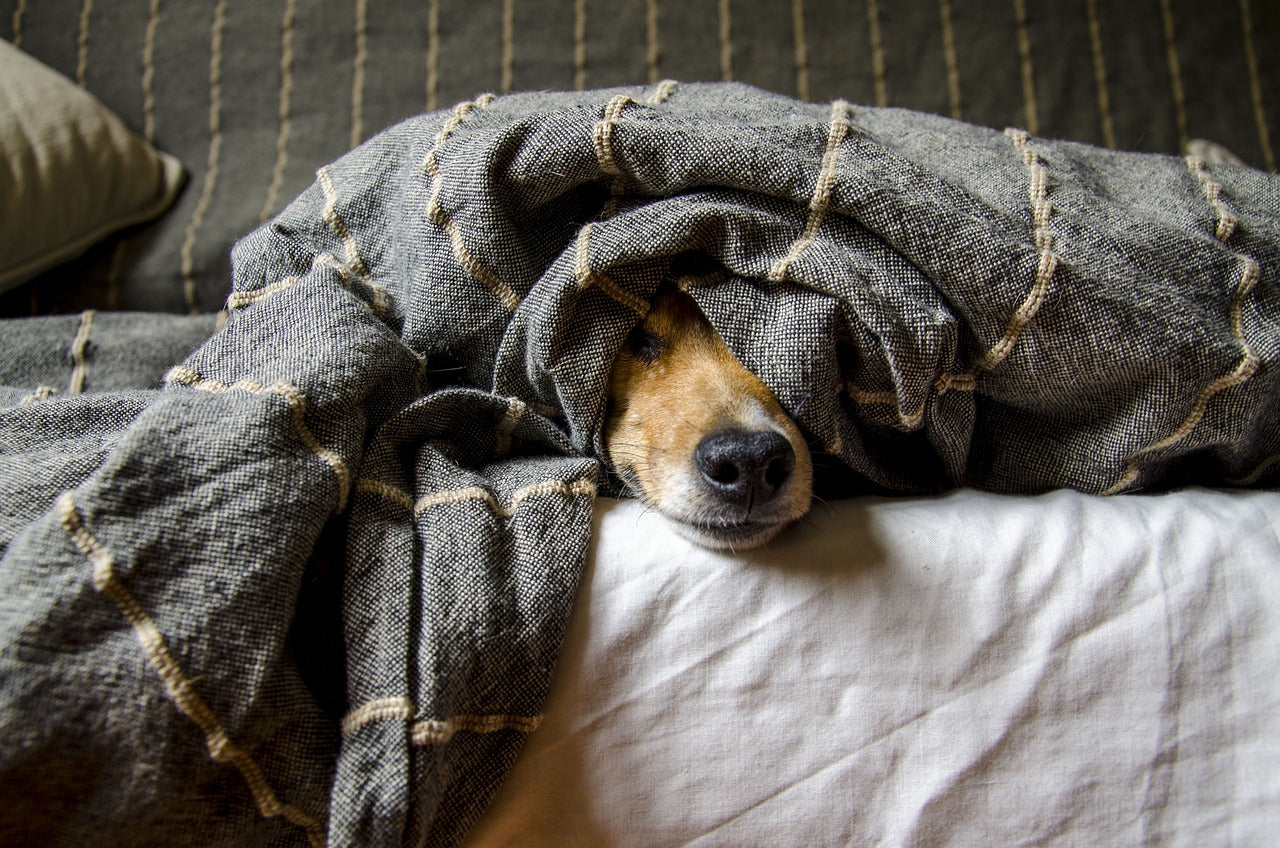
by Kim Rüegge
on Dec 26 2024
"What's healthy for one person can be toxic for another." This applies not only to humans, but also to our four-legged friends. Perhaps you've ever wondered whether your dog can snack on a few grapes while you're enjoying a bowl of them. The answer is clear: No, dogs are not allowed to eat grapes. In this article, I'll explain why this is the case, what the dangers are, what alternatives there are, and which snacks your dog will enjoy.
So are grapes now taboo for my dog?
First things first: Yes, grapes are taboo for your dog! Grapes and raisins can cause severe, sometimes life-threatening poisoning in dogs. The exact reason for this has not yet been conclusively determined. However, scientists suspect that a specific substance in grapes is responsible for this toxic effect, although this substance has not yet been identified. What is known, however, is that even small amounts can be dangerous for dogs.
The danger depends on the amount of grapes or raisins ingested, as well as the dog's weight and individual sensitivity. For some dogs, just 10 grams of grapes per kilogram of body weight is enough to cause poisoning. With raisins, the effect is even more concentrated, as they contain less water.
The symptoms of grape poisoning can appear quickly, but sometimes only after several hours. Typical signs include:
Vomiting : Often within a few hours of consumption.
Diarrhea : Can also occur very quickly.
Lethargy : Your dog seems weak and apathetic.
Loss of appetite : Your dog refuses to eat.
Abdominal pain : This may be manifested by restlessness or whining behavior.
Kidney failure : In severe cases, acute kidney failure may occur, which is characterized by increased or decreased urination and, in severe cases, complete failure of urine production.
If left untreated, such poisoning can be fatal. If you suspect your dog has eaten grapes or raisins, don't hesitate: Contact your veterinarian or animal hospital immediately. The sooner action is taken, the better the chances that your dog will escape without lasting damage.
Are there any exceptions?
You may have heard stories from dog owners whose dogs ate grapes without showing symptoms. However, this doesn't mean these dogs are "immune." Every dog reacts differently to toxic substances. Some dogs can digest small amounts of grapes without visible consequences, while others become seriously ill even with the smallest amount. There is no safe amount, and therefore it's better not to take any risks.
Healthy alternatives for your dog
Fortunately, there are many healthy and delicious snacks that you can safely offer your dog. Here are some suggestions:
Types of fruit that dogs can tolerate:
Carrots: Crunchy, low in calories and rich in beta-carotene – perfect for chewing and snacking.
Apples: Be sure to remove the core and seeds, as they contain toxic hydrogen cyanide.
Bananas: A sweet treat rich in potassium. Make sure your dog only gives them in moderation, as they contain a lot of sugar.
Blueberries: Full of antioxidants and a great little snack between meals.
Cucumbers: Low in calories and refreshing, especially popular in summer.
Strawberries: Sweet and full of vitamins, but as with all fruits, only in moderation.
Vegetables suitable as a snack:
Sweet potatoes: Gently cooked and served in small pieces.
Broccoli: Very nutritious in small quantities and lightly steamed.
Zucchini: A neutral, easily digestible snack.
Of course, it's not just the alternatives that are interesting, but also potentially other dangerous foods. We've already written several blog posts on this topic. We'll link to three of them here:
Can dogs eat peanuts?
Can dogs eat chocolate?
What shouldn't dogs eat? Part 1
What about ready-made dog snacks?
In addition to fruits and vegetables, you can also choose snacks made specifically for dogs. However, make sure they don't contain added sugar, spices, or preservatives. It's worth checking the ingredients list and choosing products with natural ingredients.
Practical tip: How do you avoid dangers for your dog in everyday life?
Store grapes safely : Make sure grapes and raisins are stored out of reach of your dog, such as in locked drawers or on high shelves.
Inform all family members : Children and visitors should know that grapes and raisins are taboo for dogs.
Alert behavior : Watch your dog and keep him away from tables or food scraps to avoid accidents.
Conclusion
Dogs and grapes – this is a combination you should definitely avoid. While it may be tempting to give your dog a small piece, even a small amount can pose health risks. With alternatives like carrots, apples, or blueberries, you can offer your four-legged friend healthy and tasty snacks that will enjoy and benefit them. Always remember: better safe than sorry. If your dog does eat grapes or raisins, don't hesitate to contact a veterinarian immediately. With proper attention and healthy alternatives, your dog will stay happy and healthy.
Tradidog motto: Even if you can't believe it: Keep your hands off grapes!
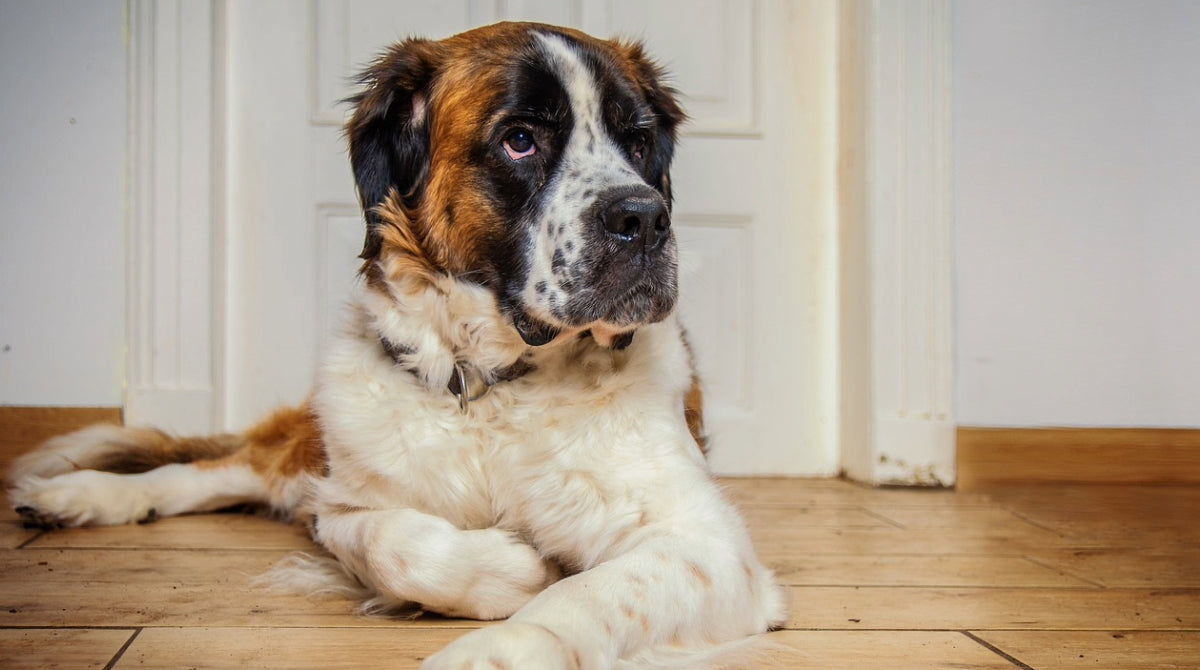
Everything about St. Bernard dogs
by Kim Rüegge
on Dec 23 2024
"A dog is a heart on four paws." This saying describes few breeds better than the St. Bernard. Made famous by the legend of Barry, the heroic avalanche rescue dog, this Swiss dog breed not only has a fascinating history but also a unique character. The St. Bernard stands for strength, gentleness, and loyalty. In this article, you'll learn everything you need to know about this impressive breed—from its origins to life with a St. Bernard to practical tips.
Origin and History: The Legend of the St. Bernard
The St. Bernard has a rich history dating back to the 11th century. Monks at the hospice on the Great St. Bernard Pass—an important pass in the Valais Alps—bred dogs to protect and accompany travelers and pilgrims. The harsh weather conditions of the region demanded a robust and resilient breed. The ancestors of today's St. Bernards were somewhat smaller, but just as strong and adaptable.
The breed became famous thanks to Barry, who rescued over 40 people from snow avalanches between 1800 and 1810. His story made the St. Bernard a symbol of rescue and loyalty. Interestingly, the image of the St. Bernard with the iconic barrel around its neck only later emerged through artistic depictions. Today, the St. Bernard is not only the national dog of Switzerland, but is also known and appreciated worldwide.
Modern breeding began in the 19th century, when size and stature were specifically promoted. In 1884, the St. Bernard was the first dog breed to be registered in the Swiss Dog Register. There are two main varieties: short-haired (stock-haired) and long-haired St. Bernards.
Character, attitude and life with a St. Bernard
Character: The gentle giant
The Saint Bernard is a calm, gentle dog, particularly impressive for its strong loyalty and patience. These qualities make it an excellent family dog, especially if there are children in the household. Despite its imposing size, it is often known as the "Gentle Giant." Saint Bernards are alert, watchful, and protective without being aggressive.
Requirements for keeping
A St. Bernard is not a dog for small apartments or people short on time. Keeping them presents special challenges:
Space requirements: With a weight of up to 80 kg and a shoulder height of up to 90 cm, they require a lot of space. A house with a garden is ideal.
Exercise: Saint Bernards aren't elite athletes, but they do need regular exercise. Long walks, preferably in nature, are sufficient. Climbing stairs or strenuous exercise should be avoided to protect their joints.
Grooming: Long-haired dogs, in particular, require daily brushing to prevent matting. Their ears should also be checked and cleaned regularly. St. Bernards also tend to drool, which is something to consider when choosing your dog's fur.
Life with a St. Bernard
A St. Bernard brings peace and serenity to everyday life, but also requires a great deal of dedication. His gentle nature makes him a wonderful companion, but his size and weight present practical challenges. For example, you should make sure your car is large enough to transport him safely. He also needs a permanent sleeping place that meets his needs.
Saint Bernards aren't dogs that bark excessively, but they can be alert. With proper training, which should be loving but consistent, they develop into well-balanced companions. Their friendly nature also makes them a good second dog if socialized early.
Health aspects
Unfortunately, St. Bernards are prone to a number of health problems, including:
Hip and elbow dysplasia: Joint disorders are common in this breed. Regular veterinary visits and avoiding obesity are essential.
Heart problems: These can occur especially in old age.
Gastric torsion: A serious and potentially life-threatening condition common in large dog breeds. Smaller, more frequent meals can help prevent it.
The life expectancy of a St. Bernard is 8 to 10 years. A balanced diet, regular exercise, and plenty of love will help ensure a happy life.
Is it easy to acquire a St. Bernard?
Buying a St. Bernard requires careful planning. Reputable breeders place great importance on the health and welfare of their animals. Breeders are often members of the Swiss St. Bernard Dog Club (SKBH) or similar associations. A St. Bernard puppy typically costs between CHF 2,000 and CHF 4,000. Alternatively, it's worth checking out animal shelters, where St. Bernards occasionally find new homes.
Before purchasing one, you should make sure that you have the space, time and resources to meet the needs of such a dog.
Conclusion
The St. Bernard is more than just an impressive dog—he is a gentle giant with a big heart. His history, character, and majestic appearance make him a unique breed. However, keeping a St. Bernard requires responsibility, patience, and dedication. Those who meet these requirements will find in him a loyal and loving companion for many years.
To better understand the fascination of this breed, we recommend the following video:
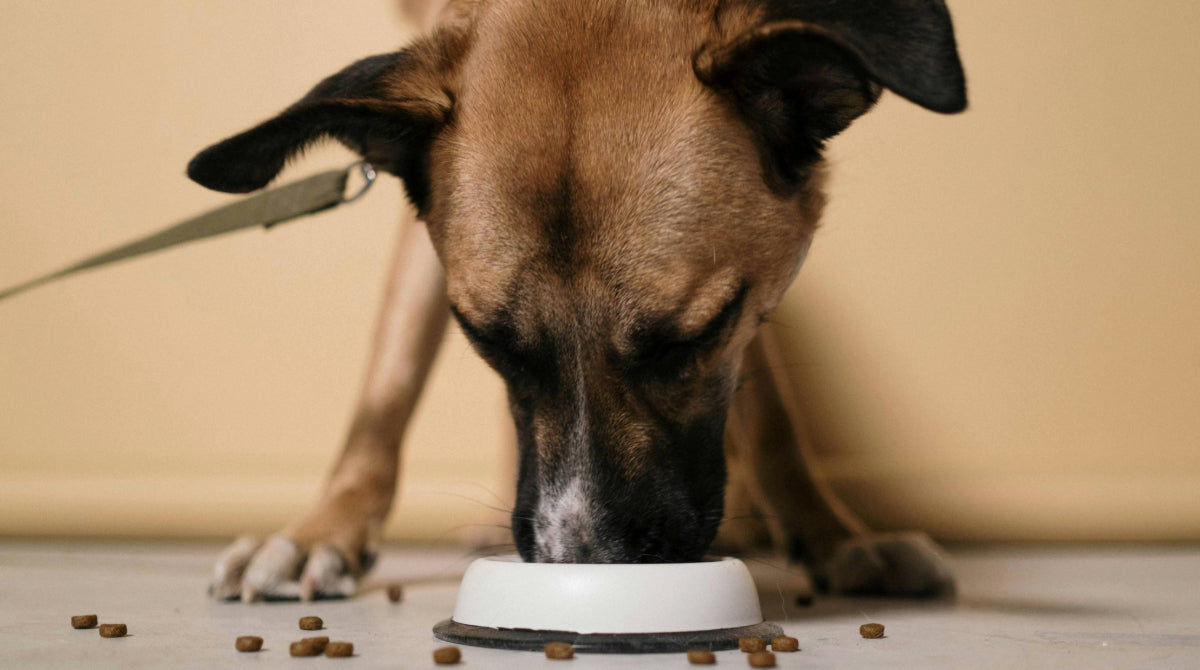
by Kim Rüegge
on Dec 21 2024
If dogs could talk, they'd probably often ask us, "What do you have there, and can I eat that too?" Opinions are divided when it comes to peanuts. Are they a healthy snack, or are they better suited only to humans? To ensure your four-legged friend's well-being, we'll take a look at whether and when peanuts can be included in your dog's diet.
Can dogs safely eat peanuts?
The answer is: It depends! Peanuts are generally not toxic to dogs, but there are some important points to keep in mind.
Salted or spiced peanuts: Stay away! Salt and spices are not suitable for dogs and can lead to serious problems. Too much salt can cause stomach problems, cardiovascular problems, or even salt poisoning. Spices like chili or paprika can irritate your dog's mucous membranes.
Natural, unsalted peanuts: Dogs can eat these in moderation, as long as they don't have an allergy. Peanuts contain healthy fats, protein, vitamin B3, and vitamin E, which can be beneficial for your dog. However, they are also very high in calories, which can lead to obesity if consumed regularly.
Allergies and intolerances: Some dogs are allergic to peanuts. Signs of an allergy include:
itching
Skin redness
Vomit
Diarrhea
Breathing problems or swelling (emergency!) Give your dog only a tiny amount the first time and observe him closely. If an adverse reaction occurs, consult your veterinarian immediately.
Raw peanuts in the shell: These are not recommended. The shell is difficult to digest and can cause digestive problems or even constipation. There is also a risk of choking, especially in smaller dogs.
Why should you be careful with peanuts?
Although peanuts contain beneficial nutrients, they should always be considered an occasional snack and not a regular part of your dog's diet. Too much fat can lead to pancreatitis (inflammation of the pancreas) over time. Dogs with existing health problems, such as obesity or sensitive stomachs, should avoid peanuts altogether.
Alternatives to peanuts
There are many alternatives that are safer and often healthier. Here are a few ideas for snacks your dog can enjoy without worry:
Healthy alternatives
Carrots : Crunchy, healthy, and perfect for dental care. They're low in calories and rich in beta-carotene.
Apple slices (without seeds) : Fresh, delicious, and rich in fiber and vitamins. Be sure to remove the seeds, as they contain traces of cyanide.
Banana pieces : In large quantities, a sweet treat that provides potassium and vitamin B6.
Cucumber : Refreshing and low in calories—perfect for hot days. Cucumbers are also rich in water, helping to hydrate your dog.
Sweet potatoes (cooked) : Nutritious and easily digestible, they contain many vitamins and fiber.
Nut-based alternatives
Other nuts can also be suitable as a snack in moderate amounts, provided they are specially prepared and safe for dogs:
Almonds (unsalted and in small amounts) : Almonds are not toxic, but they are difficult to digest and should only be given occasionally. Smaller dog breeds should avoid them.
Chestnuts (cooked) : Sweet chestnuts are a good, dog-friendly alternative. They are low in fat and contain beneficial vitamins such as B6 and C.
Walnuts (not black walnuts) : These can be given in tiny amounts, but they contain a lot of fat and should only be included occasionally.
Pecans and macadamia nuts : These are absolutely taboo because they are toxic to dogs and can cause severe poisoning.
If you give your dog nut-based products, make sure they do not contain harmful additives such as sugar, salt, or xylitol.
Can peanut butter be an option?
Peanut butter is often touted as a snack for dogs. However, the same rule applies here: only in moderation and without additives such as sugar, salt, or the dangerous sweetener xylitol, which is highly toxic to dogs. A small dab on a dog toy or as a hiding place for medication can be fine – but always check the ingredients list.
Foods that dogs should never eat
In addition to the alternatives mentioned above, there are some foods that should be avoided at all costs because they are toxic or indigestible for dogs:
Chocolate : Contains theobromine, which is extremely toxic to dogs and can cause heart problems or even death.
Onions and garlic : These can destroy your dog's red blood cells and lead to anemia.
Grapes and raisins : Even small amounts can lead to acute kidney failure.
Avocado : Contains persin, which can cause gastrointestinal upset and shortness of breath.
Foods containing caffeine : Coffee, tea or cola can lead to overstimulation of the nervous system.
Please take a look at our comprehensive blog post on this topic.
Conclusion
Peanuts can be an occasional snack for dogs in small quantities, provided they are unsalted, unseasoned, and without the shell. They contain beneficial nutrients, but due to their high fat content, they are only suitable in small amounts. Allergies are another potential risk, so you should always exercise caution.
If you want to play it safe, there are plenty of healthier alternatives like carrots, apple slices, or cucumbers that your dog is sure to love. And always remember: snacks are a great reward, but they should never replace the main meal.
One last tip: Don't let your dog's big eyes persuade you to give him your seasoned snacks—no matter how sweet he looks! His health should always come first.
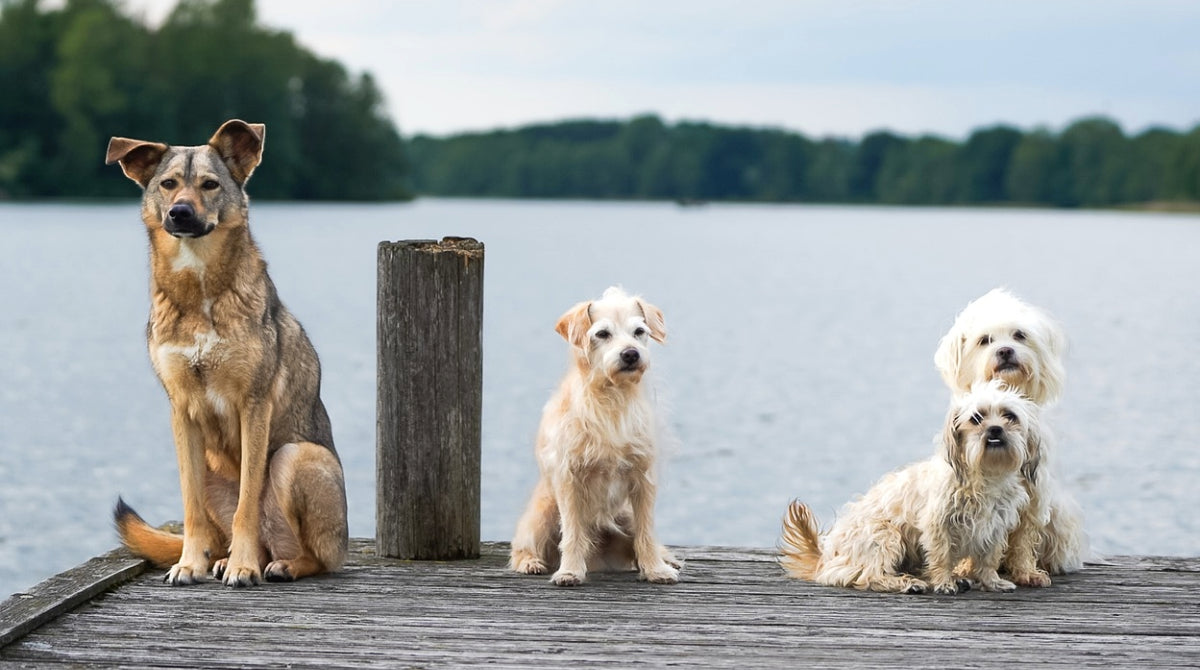
by Kim Rüegge
on Dec 02 2024
The decision to add a dog to your family involves many considerations. One of the most common questions is, "Which dog is right for me if I don't want dog hair all over my house?" Perhaps you suffer from a dog allergy, or you simply want a low-maintenance home. The good news: There are dogs that shed little or no hair. In this article, I'll introduce you to some of these dog breeds, explain why they shed less, and give you tips on what to look for when choosing one of these four-legged friends.
Why do some dogs shed less?
We've already covered the topic of hair loss in dogs in more detail in another blog post . But here's a quick recap. Dogs that shed less often have special coat types or specific coat growth cycles. Here are the main reasons:
Single or curly coat : Breeds such as Poodles or Bichon Frisés have curly coats that hold loose hairs instead of shedding them.
No undercoat : Many dogs with low shedding do not have a double coat that is shed during the warmer months.
Continuous hair growth : In dogs like the Maltese, the fur grows continuously and does not fall out in large quantities.
Dog breeds that shed little to no hair
In the following list, we present three smaller and three larger dog breeds that shed little to no hair. Please note: Don't expect these dog breeds to never leave a single hair in your home.
Smaller dog breeds that don’t shed
Bichon Frise
Coat type : Curly and soft.
Special feature : Hardly sheds hair and is hypoallergenic.
Size : 23-30cm, 3-5kg.
Maltese
Coat type : Long, silky, without undercoat.
Special feature : Hair loss minimal, but daily brushing necessary.
Size : 20-25 cm, 3-4 kg.
Yorkshire Terrier
Coat type : Long, smooth, without undercoat.
Special feature : Hardly loses hair, resembles human hair.
Size : 20-23 cm, 2-3 kg.
Larger dog breeds that don't shed
Poodle (Standard)
Coat type : Dense, curly, without undercoat.
Special feature : Hypoallergenic and hardly sheds.
Size : 45-60cm, 18-32kg.
Labradoodle (large version)
Coat type : Curly to wavy, depending on the poodle content.
Special feature : Many Labradoodles hardly shed, ideal for allergy sufferers.
Size : 53-63 cm, 23-30 kg.
Little extra: Largest dog breed that sheds little to no hair
Giant Schnauzers are among the largest, lightest-shedding dog breeds. Standing at 60 to 70 cm at the shoulder and weighing 35 to 47 kg, they make impressive companions. Their dense, wiry coat hardly sheds, making them particularly attractive to people who value a clean home. However, their coat requires regular grooming, including brushing and trimming, to prevent matting and maintain healthy skin.
Note: Despite the minimal amount of hair, all of these breeds require regular grooming to keep their coat healthy and free from matting.
Are these dogs hypoallergenic?
Just to refresh your knowledge: Hypoallergenic means that a product or animal (e.g., a dog) is less likely to trigger allergies because it produces only small amounts of potentially allergenic substances such as dander, saliva, or hair. However, it does not completely protect against allergic reactions, as no breed or product is completely allergen-free.
Many of the breeds mentioned are considered hypoallergenic because they shed less hair and dander – the most common triggers of allergies. However, no dog is completely allergy-free. Tolerance can vary from individual to individual, so you should spend time with your chosen breed before adopting to ensure that no allergy symptoms occur.
Care requirements: What you should know
Dogs that shed little often have coats that require more care . Here are some tips to keep your dog's coat in top condition:
Regular brushing : Even dogs that hardly shed need regular brushing to prevent matting and knots.
Professional trimming : Some breeds such as Poodles or Bichon Frisés benefit from regular visits to the dog groomer.
Bathe as needed : A clean coat reduces dander and ensures a healthy appearance.
Interesting facts about hair loss
Since hair loss is a topic that concerns many dog owners, we have compiled some interesting facts for you:
Seasonal coat change Many dogs shed more in spring and fall. This is a natural process in which they shed their winter or summer coats to adapt to the changes in temperature.
Stress can lead to hair loss Similar to humans, dogs can also experience increased hair loss due to stress. Changes in daily life, new environments, or loud noises can all exacerbate hair loss.
Feeding affects the coat An unbalanced diet can affect the condition of their coat. Dogs that don't get enough essential fatty acids, vitamins, or minerals are prone to dry coats and increased hair loss. Therefore, be sure to try our Tradidog products . Your dog will thank you!
Age influences hair loss Older dogs may experience increased hair loss as their skin and coat structure change over the years. Hormonal changes with age also play a role.
Regular brushing helps Regular brushing reduces visible shedding by removing loose hair before it lands on furniture and clothing. It also promotes blood circulation to the skin and keeps the coat healthy.
Conclusion
If you're looking for a dog that sheds little, you have a variety of wonderful breeds to choose from. Whether it's a poodle, Maltese, or Basenji—there's a dog to suit every lifestyle and taste. Keep in mind, however, that less shedding often means more grooming. With proper grooming and attention, your dog will not only keep your heart clean, but also your home.
Tradidog motto: Even if your dog sheds less, be prepared for the hair loss and you'll save yourself a lot of frustration.
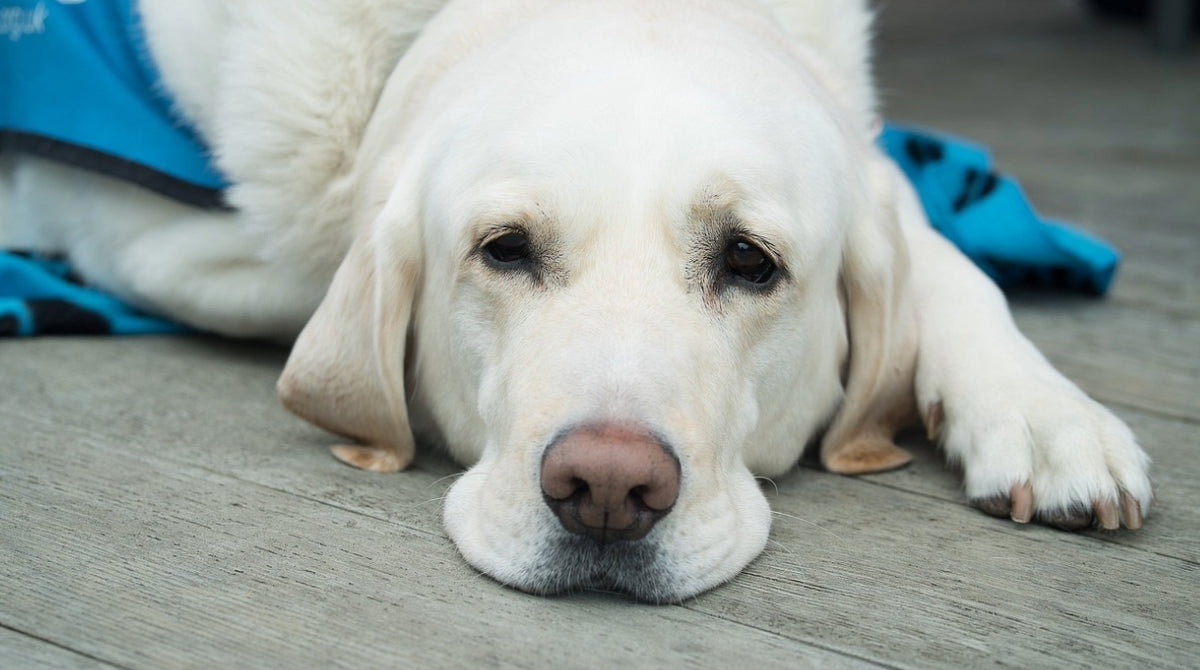
by Kim Rüegge
on Nov 29 2024
One morning, you wake up, ready to face a new day, but before you can sip your first cup of coffee, an unpleasant surprise awaits you on the living room carpet. Your dog stares at you with wide, innocent eyes, while you wonder, "What's going on?" Diarrhea in dogs is one of the less glamorous aspects of living with our four-legged friends, but it happens. And not only is it unpleasant for you, it's also a sign that something is wrong with your dog's digestive system.
Whether it's a harmless stomach upset or a more serious problem depends on several factors. In this article, you'll learn why your dog gets diarrhea, how you can help, and when it's best to call the vet.
Why does your dog get diarrhea?
Diarrhea is not a disease, but a symptom that can be caused by various factors. Here are the most common:
Dietary causes
Sudden change in food : A new type of food or treats can irritate a sensitive dog stomach.
Food intolerances or allergies : Some dogs are sensitive to certain ingredients such as grains, soy or certain proteins.
Eating spoiled food : Your dog may have stolen something from the trash or eaten something unknown while out for a walk.
Infections and parasites
Bacterial infections : Salmonella, E. coli or Campylobacter can cause diarrhea.
Viruses : Parvovirus or rotaviruses are known triggers.
Parasites : Worms or Giardia are common culprits, especially in young dogs.
Stress and excitement
Changes like moving, visiting strangers, or even a visit to the vet can disrupt your dog's gastrointestinal tract.
Diseases of the organs
Liver or kidney problems , pancreatitis (inflammation of the pancreas) or inflammatory bowel disease can cause chronic diarrhea.
Symptoms you should keep an eye on
Diarrhea can vary in intensity. Look for the following signs to help you assess the severity of the problem:
Frequency and consistency : Does your dog have a single bout of soft stools, or does he have several bouts of watery diarrhea a day?
Color of stool : Bloody or black (tarry) diarrhea indicates internal bleeding.
Accompanying symptoms : loss of appetite, vomiting, lethargy or fever.
Signs of dehydration : Dry mucous membranes, sunken eyes or heavy panting are warning signs.
What can you do if your dog has diarrhea?
If your dog has diarrhea, you can often help with simple measures.
Take a feeding break
Don't give your dog any food for 12 to 24 hours to allow his digestive tract to settle. However, make sure he always has access to fresh water to avoid dehydration.
Offer light, bland food
After the feeding break, you can start with easily digestible food:
Boiled rice with chicken (no spices).
Low-fat cottage cheese or potatoes
Zucchini steamed and cooked
cottage cheese
unsweetened applesauce
Electrolyte solution
If your dog is already weakened, an electrolyte solution can help balance fluid and mineral levels. Ask your veterinarian about suitable products.
Probiotics
Probiotic supplements can support the intestinal flora and help restore balance to the digestive tract.
When should you go to the vet?
There are situations in which you should not hesitate for long:
Persistent diarrhea lasting more than 24 hours, especially if your dog appears lethargic.
Blood in the stool or black, tarry diarrhea.
High fever , severe vomiting, or signs of dehydration.
Puppies or older dogs are particularly at risk and should be examined by a veterinarian more quickly if they have diarrhea.
Possible treatments at the veterinarian
The veterinarian will determine the exact cause of the diarrhea. The following measures can be taken:
Stool sample analysis : To identify parasites, bacteria or viruses.
Blood test : To check organ function.
Medications : Antibiotics for bacterial infections, worm treatments or medications to regulate the intestinal tract.
Infusions : To combat dehydration and restore electrolyte balance.
Prevention: How to keep your dog healthy
Slow food changes : Give your dog time to get used to new food by introducing it gradually over 7-10 days.
Regular deworming and preventative examinations.
No trash or unknown snacks : Make sure your dog doesn't pick up anything fresh from the ground outside.
Reduce stress : Create a calm and stable environment to prevent stress-related diarrhea.
A quick aside: We at tradidog contribute to better health for your dog with our dog food supplements . Be sure to try one of our products to do something good for your dog. We recommend the Starter Set Classic to get you started:
Conclusion
Diarrhea in dogs is a symptom that can have many different causes – from a harmless stomach upset to more serious health problems such as infections or organ disease. As a dog owner, it's important to be vigilant and closely monitor the circumstances. Short-term, one-off diarrhea is often harmless and can be easily controlled with a break from feeding and a bland diet.
However, if diarrhea occurs more frequently, lasts longer, or is accompanied by symptoms such as vomiting, fever, or blood in the stool, you should definitely consult a veterinarian. Puppies, older dogs, or animals with pre-existing medical conditions are particularly at risk and need immediate attention to avoid complications such as dehydration.
With a balanced diet, gradual food changes, and regular veterinary checkups, you can prevent many causes of diarrhea. This way, you can ensure that your dog stays healthy and you can enjoy everyday life together without worry.
Tradidog motto: If your dog has diarrhea again, keep a close eye on it!
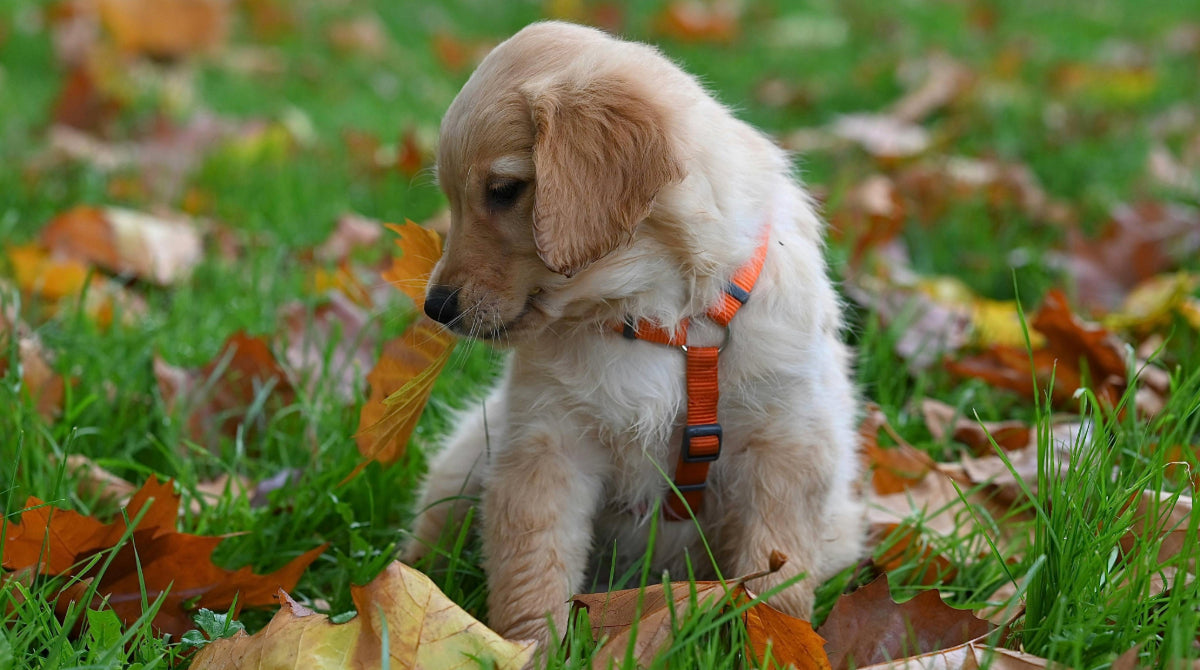
by Kim Rüegge
on Nov 26 2024
You're leisurely strolling through nature with your dog, and suddenly he stops. Instead of sniffing an interesting scent or chasing a stick, he begins to nibble on a blade of grass with relish. Sounds unusual? Eating grass is actually a behavior that occurs in many dogs and is often confusing. Is it a harmless snack, a hidden cry for help from your body, or simply boredom? In this blog post, you'll learn why dogs eat grass, when you should pay attention, and how to better understand this behavior.
Why do dogs eat grass?
Let's start with the most important question. There are several explanations for why dogs eat grass. Here are the most common:
Instinct and remnants of evolution
Our dogs are descended from wolves, and wolves occasionally eat plants to supplement their diet. Prey animals such as rabbits or rodents that wolves eat often contain plant matter in their gastrointestinal tract. So, your dog may be following a natural instinct by eating grass.
Nutrient deficiency
Some dogs eat grass because they're looking for certain nutrients or fiber that are lacking in their diet. Grass can help regulate digestion, especially if their diet lacks plant-based nutrients.
Stomach problems and self-healing
A common theory is that dogs eat grass to relieve nausea or stomach problems. By eating grass, they often stimulate vomiting and clear their stomachs of indigestible substances or irritants.
Boredom or stress
Sometimes it's simply a form of entertainment. When dogs lack mental or physical stimulation, they seek out alternative activities—eating grass is one of them. Stress or nervousness can also trigger this behavior.
Simple taste
Yes, grass can be delicious! Some dogs just seem to enjoy it, especially fresh, young grass.
Is it dangerous if your dog eats grass?
Generally speaking, grass-eating is harmless for dogs in most cases. However, there are a few things you should keep in mind:
Pesticide and chemical hazards: Grass growing in public parks or along roadsides may be treated with pesticides, herbicides, or other chemicals. These substances are toxic to dogs and can cause severe poisoning.
Parasite risk: Grass can also harbor parasites such as lungworms or other pests. These can enter your dog's body through the grass.
Excessive grass eating and vomiting: If your dog vomits frequently after eating grass or if it becomes a compulsive habit, it could indicate an underlying problem, such as an upset stomach, gastritis, or other digestive issues.
What can you do if your dog eats grass?
Observe the behavior: If your dog eats grass occasionally, it's usually nothing to worry about. Notice whether he eats normally afterward and whether he seems comfortable. If the behavior becomes compulsive or additional symptoms appear, you should take a closer look.
Check your dog's diet: Make sure your dog is getting a balanced diet. If you feel he's lacking fiber, you can offer vegetables like carrots or pumpkin to meet his needs.
Choose safe grass areas: Only allow your dog to graze on grass that hasn't been treated with pesticides or other chemicals. Your own yard is ideal if you can ensure that no hazardous substances are used.
Consult your veterinarian: If your dog is eating excessive amounts of grass, vomiting frequently, or exhibiting other health problems, a visit to your veterinarian is recommended. They can determine if there is a health issue and what treatment is appropriate.
Home remedies and alternatives
If your dog eats grass out of boredom or nutrient deficiency, you can offer him alternatives:
Vegetables and fruits : Carrots, cucumbers or apple slices are great snacks that also provide fiber.
Herbs and cat grass : Cat grass is non-toxic and offers a safe alternative if your dog finds eating grass a pleasant activity.
Sufficient activity : Provide enough mental and physical stimulation to avoid boredom.
As you can see in the picture below, dogs love to let off some steam. Therefore, we believe in the principle of live and let live, as long as it's within normal limits.
Conclusion
Your dog's grass-eating behavior may seem strange, but in most cases it's harmless and often instinctive. As long as your dog is healthy and isn't eating dangerous amounts or contaminated grass, there's nothing to worry about. However, it's worth observing their behavior and ruling out possible causes such as boredom, nutrient deficiencies, or stomach problems. If you're unsure or if there are accompanying symptoms, it's always best to consult a veterinarian. Ultimately, the goal is to keep your dog healthy and happy—with or without grass.
Tradidog motto: If he eats a little grass every now and then, take it easy and keep having fun!
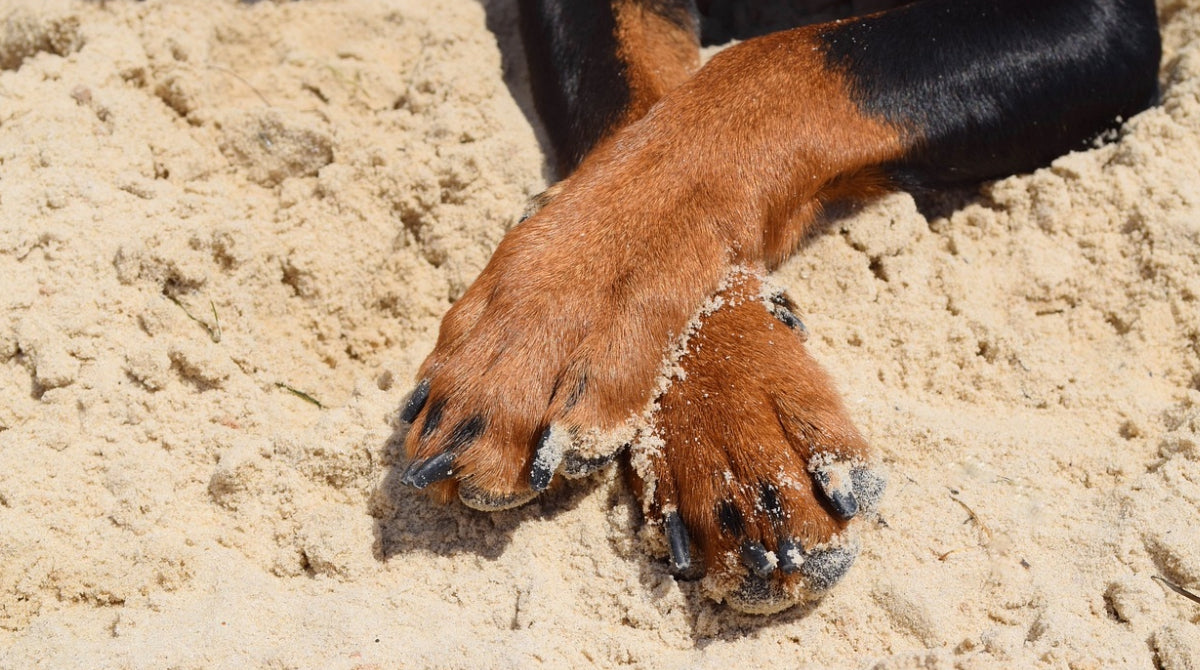
My dog constantly licks his paws
by Kim Rüegge
on Nov 23 2024
You've probably experienced this before: You're sitting comfortably on the couch, your dog is relaxing next to you, and suddenly you hear that unmistakable sound – lick, lick, lick . You look over, and there it is again, the sight of your dog devotedly licking its paws as if it were about to turn them into chocolate. (Wait, stop, is my dog even allowed to eat chocolate? You'll find out the answer in a separate blog post.) But let's get back to the topic at hand. Sometimes, licking like this is quite sweet, maybe even soothing. But if your dog is constantly doing it, it not only becomes annoying, but can also indicate a serious problem. Why do dogs do this, and what can you do about it? Let's take a closer look.
Why does your dog lick his paws?
Paw licking isn't unusual per se. Dogs use their tongues to clean themselves or treat minor injuries. It's a natural instinct and sometimes simply part of grooming. But when licking gets out of hand, there's often a reason you shouldn't ignore. It could be a physical problem, but it can also be caused by emotional factors like boredom or stress. So, it's important to pay close attention to understand what your dog is trying to tell you through their behavior.
Possible causes of constant licking
One of the most common causes of excessive paw licking is allergies . Dogs can be allergic to pollen, grass, dust mites, or certain ingredients in their food. These allergies often manifest as itching, especially on the paws. So, if your dog licks more intensively during pollen season or after eating a certain food, an allergy could be the trigger.
But skin problems are also common suspects. Chemicals like cleaning products or road salt in winter can irritate the sensitive skin on the paws. This leads your dog to try to relieve the irritation by licking.
Injuries or foreign bodies such as small splinters, thorns, or stones are another possible cause. Dogs instinctively try to remove these foreign bodies by licking. A close look at the paws can often provide clarity.
Not to be forgotten are parasites such as fleas and mites, which can lead to unbearable itching. Mites, in particular, like to settle in the spaces between the paws.
Finally, there are behavioral issues . Stress, anxiety, or simply boredom can cause your dog to constantly lick his paws. It's a form of self-soothing, similar to nail biting in humans.
Symptoms to look out for
Excessive paw licking is often just the tip of the iceberg. Pay attention to whether your dog's paws are red or swollen. Sometimes bald patches or discoloration in the fur also appear, especially between the toes. These are caused by constant licking and moisture, which further irritates the skin. Open wounds or scabs are a clear sign that licking has already led to serious skin irritation or infection.
What can you do if your dog constantly licks his paws?
The first step is to check the paws regularly. After every walk, check for foreign objects like small stones or thorns. Clean the paws with a mild, dog-friendly care product, especially if your dog has walked through mud or over road salt.
In winter, you can rub your dog's paws with a special paw balm or wax to protect them from cold and salt. This not only prevents licking but also keeps the skin supple and healthy.
When should you see a veterinarian?
If the licking doesn't stop and you can't find an obvious cause, a visit to the vet is recommended. Especially if the paws are inflamed, your dog is limping, or appears lethargic, you shouldn't wait any longer. The vet can determine the exact cause and provide targeted treatment through skin tests, blood tests, or allergy tests.
Possible treatments at the veterinarian
Treatment, of course, depends on the cause. If an allergy is present, the veterinarian may suggest special medications or even a hypoallergenic diet. Skin infections or injuries are treated with antibiotics or anti-inflammatory ointments. In more severe cases, such as mite infections, special anti-parasitic medications are necessary.
If the licking is caused by stress, your veterinarian may also recommend calming measures or consult an animal behaviorist.
How can you prevent licking?
Prevention is key. Regular paw care is key. Make sure to check your dog's paws after every walk and keep them clean. Provide your dog with plenty of exercise so they don't resort to licking out of boredom. Also, remember to avoid known allergens as much as possible.
Home remedies and their effectiveness
Sometimes simple home remedies can help. Chamomile tea is excellent for soothing irritated paws. Dip a clean cloth in the cooled tea and gently dab the paws. Coconut oil has anti-inflammatory and soothing properties and can be applied to the paws in small amounts. However, these remedies should only be used as a supportive measure. If symptoms persist, a visit to the veterinarian is essential.
Conclusion
If your dog is constantly licking their paws, it could be a sign of a variety of problems—from allergies to injuries to stress. It's important to identify the cause and act accordingly. With regular grooming, a watchful eye, and veterinary assistance if needed, you can help your dog feel better again. Paw licking is not only annoying, but can have serious health consequences if ignored. So, it's better to take a closer look and act early to keep your four-legged friend happy and healthy.
Tradidog motto: Be attentive and give your all so that your dog continues to respond to "Give paw"!
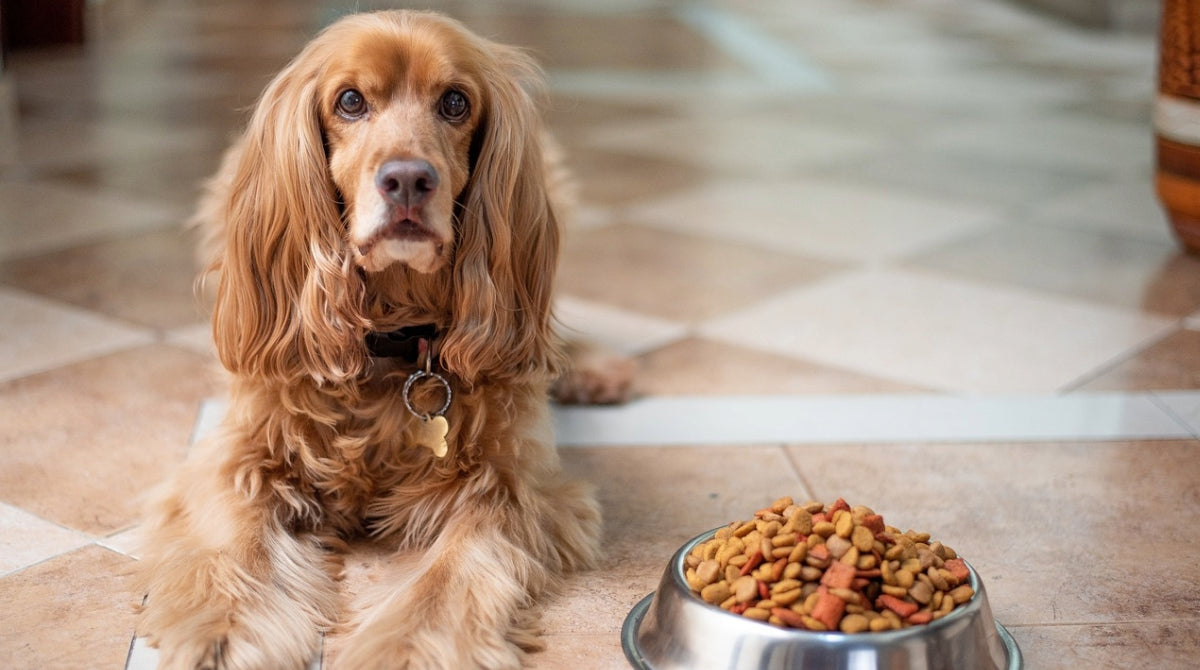
by Kim Rüegge
on Nov 20 2024
Imagine you're enjoying a piece of your favorite chocolate, and suddenly your dog sits in front of you with big, pleading eyes. His look clearly says, "Hey, I want some too!" But as tempting as it may be to give your four-legged friend a piece, you should resist. Why? Because chocolate is anything but sweet for dogs—it can even be dangerous.
Why is chocolate dangerous for dogs?
Chocolate contains theobromine , a substance that is (thankfully) harmless to humans but can be toxic to dogs. Dogs metabolize theobromine much more slowly than we do, leading to a buildup in the body and potentially toxic effects.
Dark chocolate : Contains high amounts of theobromine and is therefore particularly dangerous.
Milk chocolate : Has less theobromine, but is still harmful.
White chocolate : Contains only small amounts, but can also cause problems in sensitive dogs or in large quantities.
Important: The darker the chocolate, the more dangerous it is for the dog!
Symptoms of chocolate poisoning:
In short:
Vomiting and diarrhea
Restlessness and hyperactivity
Tremors and cramps
Increased heart rate
In severe cases: cardiac arrhythmia, shortness of breath, coma
Symptoms of chocolate poisoning can vary depending on the size of the dog, the amount of chocolate consumed, and the theobromine content. They typically appear within 4 to 12 hours after consumption, but may be delayed in severe cases.
The first signs often include vomiting and diarrhea as the body tries to eliminate the toxic substance. The vomit may have the typical chocolate smell. Restlessness and hyperactivity are other early symptoms, as theobromine stimulates the central nervous system. Your dog may appear nervous, pant heavily, or move unusually frequently.
As poisoning progresses, more severe symptoms may occur. Muscle tremors , shaking , or even convulsions are common signs of a severe reaction. The heart rate may increase, leading to a rapid or irregular heartbeat (tachycardia). This may be manifested by an increased respiratory rate and weakness.
If the poisoning is left untreated, aspiration pneumonia (described in more detail in the next paragraph) can occur if the dog inhales food or liquid into its lungs while vomiting. In extreme cases, this can lead to cardiac arrhythmia , respiratory arrest , coma , and ultimately death.
Aspiration pneumonia occurs when a dog inhales parts of its stomach contents—such as undigested food, fluid, or stomach acid—during vomiting. Instead of entering the stomach, the stomach contents enter the trachea and lungs , where they can cause severe inflammation and infection.
Aspiration pneumonia is so dangerous because it not only impairs oxygen supply but also frequently leads to secondary bacterial infection . The particles and fluids that enter the lungs provide an ideal breeding ground for bacteria to multiply in the lungs, which can lead to severe pneumonia.
Input: A secondary bacterial infection occurs when bacteria colonize an already damaged or weakened area of the body and cause an infection. It is called "secondary" because it is not the original cause of the problem but develops as a result of another illness or injury .
Because symptoms can escalate quickly, it's crucial to seek immediate veterinary attention if you suspect your dog has ingested chocolate. Even small amounts can have serious effects on sensitive dogs.
What to do if your dog has eaten chocolate?
Keep calm, but act quickly
Contact your veterinarian: Indicate how much and what type of chocolate your dog ate.
In practice, the following usually happens:
Vomiting may be induced or activated charcoal may be administered to reduce the absorption of theobromine.
In severe cases, further treatments such as infusions or monitoring of cardiac function are necessary.
Alternatives to chocolate for dogs
Even if chocolate is taboo, there are many delicious and safe alternatives for your dog:
Carob (Locust Bean) : Carob is a natural, chocolate-like substance that contains no theobromine and is therefore safe for dogs. It can be used in powder or chip form and is ideal for baking dog biscuits.
Specially prepared dog chocolate : There are products on the market that look like chocolate but don't contain theobromine and are specifically formulated for dogs. However, be careful about the sugar content and feed these treats only in moderation.
Fruits and vegetables : Many dogs love fruits and vegetables. Suitable varieties include apples (without seeds), carrots, or blueberries. These snacks are not only safe but also healthy.
Homemade dog biscuits : With simple recipes, you can bake delicious and safe treats for your dog. Use ingredients like oatmeal, peanut butter (without xylitol), and carob.
Educational video
The following video explains exactly why eating chocolate is dangerous for dogs.
Conclusion
No matter how much your dog begs, chocolate is taboo for him. The substances it contains can cause serious health problems. Fortunately, there are many safe and tasty alternatives you can treat your four-legged friend to. Always pay attention to what your dog eats and inform friends and family about the dangers of chocolate for dogs. This way, your best friend will stay healthy and happy.
Tradidog motto: Don’t forget, dogs aren’t allowed to eat chocolate!
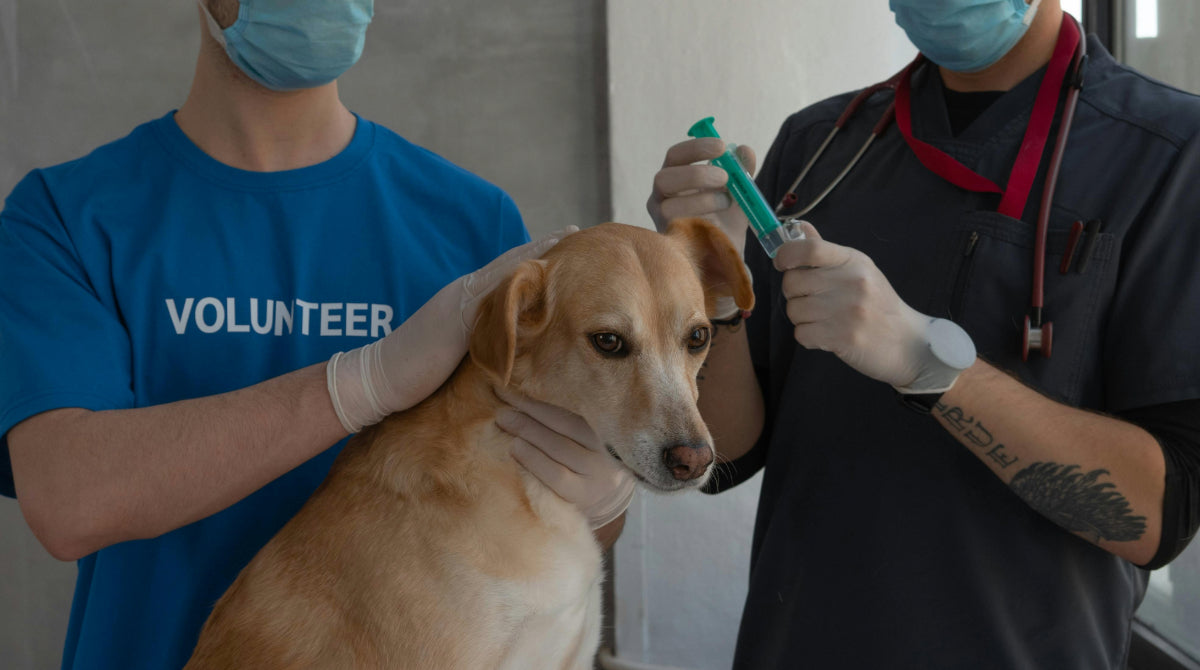
by Kim Rüegge
on Nov 17 2024
Vomiting in dogs is something every dog owner will likely encounter sooner or later. Whether it's the half-chewed sock your four-legged friend secretly devoured or the typical "grass snack" from their last walk, a gagging dog is rarely a pleasant sight. But as unpleasant as it may be, vomiting is often an important warning signal from the body.
Dogs have a very sensitive digestive system, which can raise alarm bells faster than you think. Sometimes it's just something minor, like a food gobbled down too quickly. But it can also be a sign that something more serious is afoot. And that's where you come in: With a little knowledge, you can help your dog get back on their feet faster—and maybe even avoid the occasional gagging incident.
So let’s take a look together at what lies behind the topic of “vomiting in dogs” and how you can best deal with it when your furry friend presents the contents of his stomach again.
Causes of vomiting in dogs
Vomiting in dogs can have many different causes. While some reasons are harmless and don't require significant attention, others can indicate serious health problems. Identifying the cause is the first step in helping your dog.
More harmless causes:
Eating too quickly : If your dog devours his food too quickly, it can overload his stomach, leading to vomiting.
Eating grass : Many dogs occasionally eat grass, which can irritate the stomach and trigger vomiting. This is often a natural response to cleanse the stomach.
Changing food : A sudden change in food can upset your dog's sensitive stomach. A gradual transition is recommended.
Stomach irritation : Sometimes fatty or difficult-to-digest food can put a temporary strain on the stomach.
Serious causes:
Poisoning: Consuming toxic foods or household chemicals can cause vomiting.
Gastrointestinal infections : Bacteria, viruses, or parasites can infect your dog's gastrointestinal tract.
Foreign body in the stomach : If your dog swallows objects that the body cannot digest, this can lead to a blockage.
Organic diseases : Diseases such as kidney failure, liver problems or pancreatitis can also cause vomiting.
Acute or chronic vomiting?
Not all vomiting is the same. There's an important distinction between acute and chronic vomiting that you should know. This distinction will help you better assess whether your dog has simply eaten something wrong or whether there's a more serious problem.
Acute vomiting:
Occurs suddenly and usually lasts only for a short time.
Often triggered by something your dog has recently eaten, such as unfamiliar food, grass, or spoiled food.
Often harmless if it is a one-time event and no further symptoms occur.
Chronic vomiting:
Recurrent vomiting over days or weeks.
Could indicate serious health problems such as gastritis, inflammatory bowel disease, kidney disease or even tumors.
A visit to the vet is essential to find the cause and begin appropriate treatment.
Vomiting or regurgitation?
Not everything your dog throws up is vomiting. There's an important distinction between vomiting and regurgitation that many dog owners don't know. Both processes look similar, but have different causes and require different treatment.
Vomit:
Active process : Your dog often shows signs of nausea such as drooling, restlessness, or gagging. He vomits forcefully, and the contents may contain partially digested food, bile, or mucus.
Common causes: stomach irritation, infections or other organic problems.
Regurgitation (regurgitation):
Passive process : The dog simply regurgitates food or liquids without any visible effort. This often happens shortly after eating.
The regurgitated contents are undigested and look similar to the food.
The cause could be a problem in the esophagus, such as megaesophagus. (See explanation below)
Input: Megaesophagus refers to a condition in which a dog's esophagus is enlarged and dysfunctional. The esophagus's normal function is to transport food from the mouth to the stomach through wave-like muscular movements (peristalsis). In megaesophagus, this function is impaired or completely lost. As a result, food accumulates in the enlarged esophagus instead of being passed on to the stomach.
If you are unsure which process your dog is experiencing, a veterinarian can help you tell the difference.
What to do if your dog vomits?
If your dog is vomiting, it's important to stay calm and proceed systematically. There are some simple steps you can take to help your dog quickly and determine if veterinary attention is necessary.
First measures:
Fasting : Withhold food for about 12 to 24 hours to allow the stomach to settle. However, be careful not to let your dog become dehydrated.
Water intake : Ensure your dog has access to small amounts of water. Large amounts could re-irritate the stomach.
Observe your dog:
Watch for other symptoms such as lethargy, diarrhea, fever, or bloody vomit.
If the vomiting stops after a short time and your dog otherwise appears normal, it is probably a harmless event.
When should you go to the vet?
If vomiting occurs repeatedly or is accompanied by other symptoms.
If your dog seems apathetic or shows signs of pain.
If poisoning is suspected or if your dog has swallowed a foreign object.
Timely veterinary treatment can in many cases prevent more serious complications.
Poisoning and foreign bodies
Dogs are naturally curious and often explore their surroundings with their mouths. This can lead to them swallowing dangerous or indigestible substances. Vomiting is a common symptom of poisoning and when your dog has ingested a foreign object. Therefore, it's important to recognize these risks early and act accordingly.
Poisoning:
Common toxins: chocolate, grapes, raisins, onions, garlic, alcohol, human medications.
In addition to vomiting, symptoms may include diarrhea, tremors, seizures or collapse.
Act immediately : If you suspect that your dog has ingested something poisonous, contact a veterinarian or poison control center immediately.
Foreign body:
Dogs tend to swallow things like toys, bones, or household items.
Signs: Sudden vomiting, loss of appetite, abdominal pain or constipation.
A foreign body can block the intestine and often requires surgical removal.
Food intolerances and allergies
Not every dog tolerates every food equally well. Some dogs develop intolerances or allergies to certain ingredients in their food over time. These can manifest as repeated vomiting or other symptoms. Recognizing and avoiding these triggers is crucial for your dog's well-being.
Food intolerances:
Some dogs are sensitive to certain proteins, grains or additives in their food.
Symptoms: Vomiting, diarrhea, flatulence, itching or skin problems.
Allergies:
In addition to vomiting, symptoms such as skin rashes, ear infections or severe itching often occur.
In such cases, you can conduct an elimination diet under veterinary supervision to identify the food that is causing the allergy.
Hypoallergenic food:
There are special diets designed for dogs with sensitive stomachs or allergies. These can help alleviate symptoms.
Something you should have known for some time now: We at Tradidog are the experts when it comes to food supplements. So be sure to check out our products and support your dog in leading a healthy life.
Prevention: How to prevent vomiting in dogs?
Prevention is better than cure – this saying also applies to vomiting in dogs. Many causes can be prevented with careful care and monitoring. With a few simple measures, you can help keep your dog healthy and prevent vomiting from occurring in the first place.
Feeding habits:
Avoid feeding your dog large amounts at once. Divide the food into smaller portions throughout the day.
Use anti-gulping bowls to prevent eating too quickly.
High-quality nutrition:
Make sure your dog gets a balanced, high-quality food that meets his needs.
Regular health care:
Have your dog dewormed and vaccinated regularly.
Routine veterinary checkups can help detect health problems early.
Take care of the environment:
Remove poisonous plants from your garden and keep your dog away from garbage.
Make sure your dog doesn’t eat anything unknown while walking.
With these preventative measures, you can protect your dog from many potential problems and give him a healthy and happy life.
Conclusion
We want you, as a dog owner, to enjoy your healthy dog. (Just like the one above.) We therefore draw the following conclusion:
Vomiting in dogs can have many causes, from harmless triggers like eating too quickly to serious illnesses or poisoning. Psychological factors such as stress or anxiety can also play a role. It's important to identify the cause: Acute, one-off vomiting is often unproblematic, while chronic vomiting or additional symptoms such as lethargy or bloody vomit require veterinary evaluation.
With a balanced diet, regular preventative care, and stress reduction, you can often prevent vomiting. Monitor your dog closely and act quickly if necessary to provide the best possible support.
Tradidog motto: The best comes last, for healthy dogs Tradidog is a must!
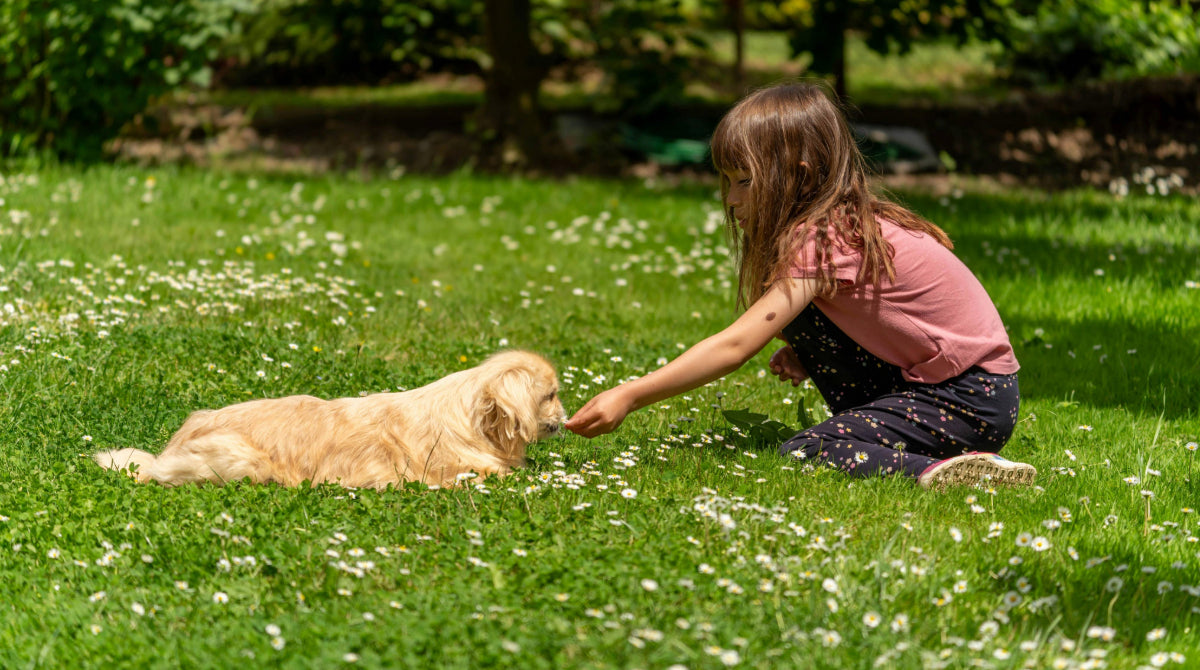
by Kim Rüegge
on Nov 14 2024
The decision to adopt a dog is not only an act of charity, but also an enrichment of one's life. As the American author Josh Billings once said, "A dog is the only creature on earth that loves you more than it loves itself." In Switzerland, numerous dogs are waiting for a loving home in animal shelters and at animal welfare organizations. This blog post highlights the benefits of dog adoption, shows where you can adopt dogs in Switzerland, explains the adoption process, and provides valuable information on legal aspects and responsibilities.
Advantages of adopting a dog
Adopting a dog offers far more than just the obvious benefit of giving an animal a new home:
Save lives and relieve pressure on animal shelters : Every animal shelter in Switzerland houses dogs waiting for a new home. By adopting, you not only save the adopted dog's life, but also make room for other animals in need.
Enriching your life : Adopted dogs often show a special sense of gratitude and loyalty. The joy of accompanying a dog from difficult circumstances to a happy life is indescribable.
Pre-screened animals : Dogs from shelters are usually medically examined, vaccinated, and microchipped. Their behavior has often been analyzed, giving you a better idea of the dog's personality and needs.
Variety of dogs : Whether mixed breeds, purebred dogs, puppies or seniors – animal shelters offer a large selection so that the right dog can be found for every lifestyle.
Lower costs : Adoption fees are usually lower than the purchase price from a breeder. You also save on vaccinations and neutering, as these are often included in the adoption package.
Where can you adopt dogs in Switzerland?
Switzerland offers numerous contact points for dog adoption:
Animal shelters : The most well-known animal shelters include:
Zurich Animal Welfare: Offers a variety of dogs and supports potential owners with advice.
Basel Animal Welfare Association: Places dogs in suitable homes.
Bern Animal Welfare: Places a large number of dogs with future owners
Animal welfare organizations :
Animal Happyend: Places dogs from Switzerland and abroad.
FOUR PAWS Switzerland: Supports national and international adoptions.
Online platforms :
Petfinder: Platform for rehoming dogs.
Tieronline: A large database of dogs for adoption.
These organizations not only offer dogs but also provide comprehensive advice on adoptions. Of course, this list is not exhaustive; the list could go on and on. Therefore, it's worth doing some detailed research.
The process of adopting a dog
Adopting a dog is a multi-step process designed to ensure that both dog and owner are a perfect match:
Research and selection : You find out about the available dogs and choose an animal that fits your lifestyle.
Contact : After selecting a dog, you contact the organization. You will often receive initial information about the animal's behavior and health status.
First meeting : Many animal shelters offer trial appointments where you can get to know the dog in a controlled environment.
Pre-inspection : A shelter employee will visit your home to ensure it is dog-friendly.
Adoption contract : After a successful preliminary inspection, an adoption contract is concluded. This contract contains information about the new owner's responsibilities and the dog's health status.
Handing over the dog : The dog moves in with you, often accompanied by a handover discussion with final tips and recommendations.
Which dogs are looking for a home?
In Switzerland’s animal shelters, you will find dogs with very different life stories:
Puppies : Often surrendered or from unplanned litters. They are playful and eager to learn, but require a lot of time and patience. You can find everything about puppies in our dedicated blog post.
Adult dogs : Many adult dogs are already trained and know basic commands. They are ideal companions for people who don't have time to train puppies.
Seniors : Older dogs are calmer and often perfect for people looking for a relaxed companion.
Animals with special needs : Dogs with physical disabilities or from difficult circumstances who need a loving home. They can be particularly grateful and loyal companions.
Challenges and responsibility
Adopting a dog also brings challenges:
Behavioral issues : Shelter dogs often have a difficult past. It can take time for them to gain trust and adjust to a new home.
Time and patience : Especially in the first few weeks, your dog needs a lot of attention to get used to it.
Financial obligations : In addition to the adoption fees, there are ongoing costs for food, care, insurance and veterinary visits.
Lifelong commitment : A dog often lives for 10-15 years. Adoption should be carefully considered, as it is a long-term commitment. At this point, we'd like to refer you to our blog series " Dogs for Beginners, " where we prepare you for the dog purchase in several steps.
Legal and organizational aspects
The following regulations apply in Switzerland:
Registration requirement : Dogs must be registered with the municipality and microchipped. Registration takes place in the AMICUS database.
Dog tax : The tax varies between 30 and 150 francs per year depending on the canton and municipality.
Leash requirement : Many cantons have leash requirements in urban areas, parks, and forests, especially during the breeding and nesting season. We have already written a blog post on the topic of leash requirements .
Liability insurance : Some cantons require liability insurance to cover damage caused by your dog.
Can everyone in Switzerland adopt a dog?
In Switzerland, not everyone can simply adopt a dog. There are certain requirements and legal regulations that vary depending on the canton and organization. Here are the key points:
Minimum age
In Switzerland, individuals must generally be at least 18 years old to adopt a dog. Some organizations require a minimum age of 21 , especially for large or demanding dog breeds.
Living situation
Apartment or house : The living situation must be suitable for keeping a dog. A small city apartment may not be suitable for larger or very active dogs.
Landlord permission : If you rent, you need the landlord’s permission to keep a dog.
Time resources
Organizations check whether the potential owner can devote enough time to caring for, training, and nurturing the dog. Those who work long hours every day and would leave their dog alone for long hours usually have fewer chances of being approved for adoption.
Financial stability
Keeping a dog involves costs (food, veterinary fees, insurance, dog tax). Many organizations assess whether the owner's financial situation is stable enough to cover these costs.
Experience with dogs
For certain breeds or dogs with special needs (e.g., behavioral problems), experience with dog ownership is often required. Some organizations recommend or require participation in dog training courses .
Cantonal regulations and breed lists
Some cantons have breed lists that restrict the keeping of certain dog breeds or impose additional requirements. For example, in the cantons of Geneva and Valais, certain dogs such as pit bulls and Rottweilers are prohibited.
In other cantons such as Zurich or Aargau, specific regulations apply to “listed dogs” (e.g. leash requirements, muzzle requirements or owner permits).
Preliminary check and probationary period
Many animal shelters and animal welfare organizations conduct a pre-home inspection to ensure the conditions are ideal for the dog. There is often also a trial period to ensure that the dog and owner get along well.
Personal suitability
Depending on the organization, people with physical or mental disabilities that might prevent them from meeting a dog's needs may be excluded from adoption. This primarily serves to protect both the animal and the potential owner.
Experience report from an animal shelter
Mona Vetsch, the well-known reporter for Swiss Radio and Television, visited an animal shelter in her series "Mona Mittendrin." The video shows life in an animal shelter and the dedication of the on-site staff.
How else you can support animal welfare
Even without adoption, you can actively support animal welfare:
Donations : Monetary donations help animal shelters cover ongoing costs such as food, medical care, and upkeep.
Swiss Animal Protection STS
FOUR PAWS Switzerland
Volunteer work : Animal shelters often seek volunteers for dog walking, grooming, or office work.
Volunteering at the Zurich Animal Welfare Association
Donations in kind : Many animal shelters are happy to receive food, blankets or toys.
Conclusion
Adopting a dog is an enriching, life-changing experience—both yours and that of your new companion. With the right preparation and support, you can provide a loving home for an animal in need. At the same time, you'll be actively contributing to animal welfare and rewarded with the unconditional love of a dog.
Tradi-Dog motto: Trying is better than studying, it's worth adopting the dog!
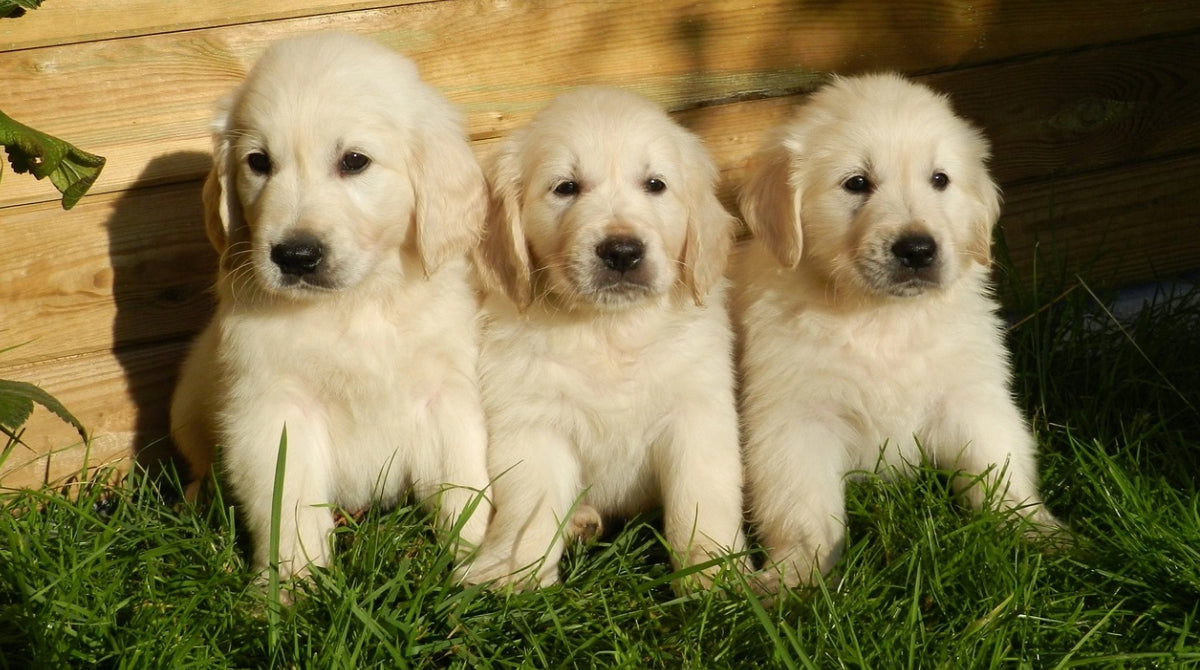
by Kim Rüegge
on Nov 11 2024
Puppies are arguably the sweetest thing the pet world has to offer: With their big eyes, clumsy paws, and boundless curiosity, they capture hearts. But as adorable as these little furballs are, keeping them comes with a lot of responsibility. From the right food and initial training steps to care and socialization—there are a lot to consider to ensure a successful start to life together and that your puppy develops into a healthy, happy companion. In this blog post, you'll learn (almost) everything about puppies so you can give your new family member the best possible start.
Before purchasing
There are many different questions to ask before purchasing a dog. This can often be overwhelming. In our series: Dogs for Beginners, we try to prepare you as best as possible for the purchase. Feel free to stop by.
Which dog breed is best suited to me and my lifestyle? Choosing a dog breed should be based on your lifestyle. If you're athletic and active, breeds like Labradors or Border Collies might be a good fit. If you have a more relaxed lifestyle, a Pug or Basset Hound might be ideal. Also consider whether you have enough time and space to meet the breed's needs.
How do I recognize a reputable breeder? A reputable breeder is transparent and will let you visit the mother dog and puppies. They will show you health certificates and ask many questions about your living situation to ensure their puppy goes to good homes.
Should I get a puppy from a shelter or a breeder? Both options have advantages. There are many dogs waiting at the shelter looking for a loving home, often mixed breeds. A breeder, on the other hand, offers you the opportunity to choose a specific breed with clear characteristics. Consider which one suits you better and make a responsible decision.
How much does it cost to keep a puppy? You should expect costs for food, vet visits, vaccinations, toys, grooming supplies, and liability insurance. In the first year, expenses can range from CHF 1,000 to CHF 2,500 or more.
Health and Care
When should my puppy go to the vet for the first time? You should take your puppy to the veterinarian within the first few weeks of adopting it. There, he will be examined, vaccinated, and dewormed.
Which vaccinations does my puppy need and when? Your puppy needs vaccinations against distemper, parvovirus, leptospirosis, hepatitis, and rabies. The vaccination schedule usually begins at 8 weeks of age. Your veterinarian will provide you with a detailed schedule.
How often should I bathe or groom my puppy? You should only bathe your puppy when necessary, for example, if he's very dirty. Regular brushing is usually enough to keep his coat clean.
What do I do if my puppy has diarrhea or vomits? Mild diarrhea can be caused by stress or a change in diet. Offer your puppy a bland diet and make sure he drinks plenty of fluids. If symptoms persist or your puppy vomits, you should consult your veterinarian.
How do I know if my puppy is in pain? Puppies often show pain through changes in behavior such as restlessness, whining, avoiding certain movements, or refusing to eat. Watch for signs of your puppy licking or protecting certain areas of his body, and consult your veterinarian if you suspect pain.
Which parasites can infect my puppy and how can I prevent them? Common parasites include fleas, ticks, and worms. You can prevent them with regular deworming and spot-on treatments or special collars. You should check your puppy for ticks after walks.
When and how often should my puppy be dewormed? Puppies should be dewormed every two weeks starting at two weeks of age until they are 12 weeks old. Thereafter, deworming is recommended every three months or as directed by your veterinarian.
Does health insurance make sense for my puppy? Yes, unforeseen veterinary expenses can arise, especially during the first few years of life. Health insurance helps cover high treatment costs, especially in the case of accidents or chronic illnesses.
How can I prevent dental problems in my puppy? Get your puppy used to brushing their teeth early with special dog toothpaste. Chews and special puppy food also help keep their teeth clean.
What do I do if my puppy is limping or injured? First, observe him to see if the limping goes away on its own. If it persists for more than a day or if he appears to be in severe pain, you should consult a veterinarian.
Which care products are suitable for puppies? Use gentle grooming products specifically designed for puppies, such as puppy shampoo, a soft brush, and paw balm. Make sure the products don't contain any irritants.
How do I know if my puppy is allergic to something? Allergies often manifest as skin problems, itching, or gastrointestinal upset. If you notice these symptoms, consult your veterinarian for possible allergy testing.
Education and behavior
How do I housetrain my puppy? Take your puppy outside regularly after sleeping, eating, and playing. Praise him lavishly when he goes to the toilet. With patience and consistency, he will quickly learn to be housebroken.
What should I do if my puppy constantly bites my hands or furniture? Puppies explore the world with their mouths. Give them an appropriate toy when they bite, and consistently say "no" or "out." This will help them learn what's allowed and what's not.
How do I get my puppy used to a leash? First, let him get used to a collar or harness. Start with short training sessions indoors and reward calm behavior. Gradually, he'll walk confidently on a leash.
When should I start training and which commands are important first? You can start training as early as week 8. Basic commands like "sit," "down," and "here" are good starting exercises. Make sure to keep the training sessions short and positive.
How does my puppy learn to be alone without developing fear? Train your puppy to be alone gradually. Start by leaving the room for only a short time and gradually increase the duration. Reward calm behavior and give your puppy a toy or blanket to provide security.
How do I stop my puppy from barking constantly? Find out why your puppy is barking (e.g., boredom, fear, excitement). Distract him with training or play, and reward him when he stays calm. Avoid inadvertently rewarding him for barking by giving him attention.
What should I do if my puppy is afraid of other dogs? Deal with fear with patience. Let him observe other dogs from a safe distance and reward relaxed behavior. Gradually, you can reduce the distance without forcing him.
How do I teach my puppy not to pull on the leash? Stop as soon as your puppy pulls on the leash and only continue the walk when the leash is slack. Reward him when he stays beside you. With patience, he'll learn that pulling doesn't get him anywhere.
How do I correct unwanted behavior without frightening my puppy? Use clear, calm commands like "No" or "Stop" and immediately redirect your puppy toward a desired behavior. Positive reinforcement through praise and treats is key to encouraging good behavior.
When and how does my puppy learn to follow certain rules in the house? Introduce rules from the beginning and be consistent. For example, decide where your dog can sleep or whether he can sit on the sofa. Praise him when he follows the rules and correct undesirable behavior immediately.
How do I foster a bond with my puppy through training? Use plenty of praise, rewards, and physical proximity during training. Shared games and positive experiences will strengthen your bond.
A lot of material to process today. To keep you interested in reading, here's a photo of a cute puppy:
Nutrition
A quick advertisement for our own benefit (we have to earn our money somehow, right?! ;-)) On the Tradidog website, you can find out everything about the best supplements for dogs and purchase them directly from our online shop. Your dog will thank you.
What is the best food for my puppy? Choose a high-quality puppy food that meets the nutritional needs of a growing dog. Your veterinarian can provide recommendations that are appropriate for your dog.
How often and how much should I feed my puppy? Puppies should be fed 3-4 times a day. The exact amount depends on age, weight, and breed. Refer to the instructions on the food packaging and adjust as needed.
Can my puppy eat human food? Many foods that are safe for us can be harmful to dogs, such as chocolate, onions, or spicy foods. It's better to stick to special dog food.
Which treats are suitable for training? Use small, healthy treats that your puppy can chew quickly. This way, you don't interrupt training and can reward him immediately.
socialization
When can my puppy meet other dogs or animals? After the initial vaccination (usually starting at 12 weeks), it's safe to introduce your puppy to other dogs or other animals. Choose well-socialized dogs initially to encourage positive experiences.
How do I get my puppy used to new people and environments? Introduce your puppy to new situations slowly. Positive experiences and rewards will help him quickly get used to unfamiliar people and places.
At what age should I take my puppy to dog training school? Many dog schools offer puppy classes starting at 8 to 12 weeks. There, your dog will learn important social skills and basic behavioral rules.
What should I do if my puppy is afraid of new situations? Stay calm and give your puppy time to adjust to the new situation. Avoid pushing him and reward brave behavior.
Everyday life and care
How much sleep does my puppy need? A puppy sleeps up to 18-20 hours a day. Sleep is important for his development and recovery. Make sure he has a quiet place to sleep.
How long can my puppy be left alone? Puppies should initially only be left alone for short periods (1-2 hours). Being alone should be trained slowly and gradually so that your puppy doesn't develop separation anxiety.
How do I keep my puppy busy without overwhelming him? Alternate short play and exercise sessions with rest periods. Brain games and simple training stimulate his mind without overtaxing him.
What should I do if my puppy cries at night? Place the basket near you so he feels safe. Gradually, you can get him used to his own sleeping space.
How do I structure my puppy's daily routine sensibly? A regular daily routine with set feeding and walking times will give your puppy security. Plan sufficient rest periods, playtime, and short training sessions.
How much exercise does my puppy need daily? Puppies need age-appropriate exercise. A general rule of thumb is 5 minutes of walking per month of age (e.g., 15 minutes for a 3-month-old puppy). Avoid overexertion.
Can I take my puppy to the office, and what should I keep in mind? Yes, if your workplace is dog-friendly. Provide a quiet space, toys, and water. Gradually introduce your puppy to the new environment and make sure he's not stressed.
How do I react if my puppy gets nervous during car rides? Start with short rides and reward relaxed behavior. A secure crate or special dog car seat can provide additional support and security.
What do I need to consider when going on vacation with my puppy? Check whether your destination is dog-friendly and what entry requirements apply to dogs. Pack everything you need, such as vaccination records, food, and a first-aid kit. Plan regular breaks.
How do I find a good dog daycare or sitter for my puppy? Visit the facility or meet the caregiver beforehand. Make sure the environment is clean and your puppy is well cared for. Get recommendations and reviews.
What are the most important things I should take with me when walking my puppy? A leash, collar or harness, poop bags, water, a small bowl, and a few treats. Depending on the length of the walk, toys or a blanket may also be useful.
Development
When does my puppy change his baby teeth? Teething usually begins at 16 weeks and is completed by 6 months. During this time, you can offer your baby chew toys to relieve pressure on his gums.
How do I know if my puppy is growing healthily? A healthy puppy is active, has a shiny coat, and clear eyes. Regular vet visits help monitor its development.
When will my puppy be fully grown? Small dogs are often fully grown at 10-12 months, larger breeds need up to 18-24 months.
How does my puppy's behavior change over time? Your puppy will go through phases of exhibiting new behaviors, especially during puberty. Patience and consistent training are especially important during this time.
How much weight should my puppy gain in the first few months? Growth varies by breed. Small breeds gain weight more slowly, while large breeds gain a lot of weight in the first year. Your veterinarian can help you monitor growth.
What physical changes are normal during puberty? Your puppy may become more restless or rebellious. Physically, their coat changes, and in some breeds, their ears and paws grow faster than the rest of their body.
How does my puppy's sleeping behavior change over time? In the first few months, your puppy will sleep up to 20 hours a day. As he gets older, his sleep periods will become shorter and he will become more active.
When should I have my puppy spayed or neutered? The right timing depends on the breed and individual factors. Talk to your veterinarian to make the best decision.
How can I encourage my puppy's mental development? Brain games, new environments, and varied training stimulate his mind. Toys that encourage thinking, such as food mazes, are ideal.
When should my puppy start walking up stairs? Climbing stairs can put strain on the joints, especially in large breeds. Wait until your puppy is at least 6 months old and allow only a few steps at first.
How long does it take for my puppy's final coat color to show? In some breeds, coat color continues to change into adulthood. This can take up to two years, depending on genetics and breed.
Legal questions
Is there a leash requirement for puppies? The leash requirement depends on where you live. Find out about the regulations in your canton or municipality. You can find out more about this important topic in this blog post about the leash requirement in Switzerland.
Does my puppy need liability insurance? Yes, liability insurance is a good idea. You are responsible for any damage your dog causes.
What laws and regulations do I have to follow as a puppy owner? Depending on the canton, there are regulations regarding leash requirements, registration, and muzzle requirements. Check with your local authority to be on the safe side.
Conclusion
Puppies represent a wonderful new beginning full of joy, but also responsibility. Their care and training require knowledge, patience, and consistency. From preventative health care to proper nutrition and socialization, there are many aspects to consider. With careful preparation and loving care, you can give your puppy the best possible start in life. This way, they will not only grow up healthy and happy, but will also develop into a loyal companion who will enrich your life.
Tradidog motto: Buying a puppy doesn't require courage, but you should still do your research beforehand!
And because they are so cute, here is another photo of puppies to finish.
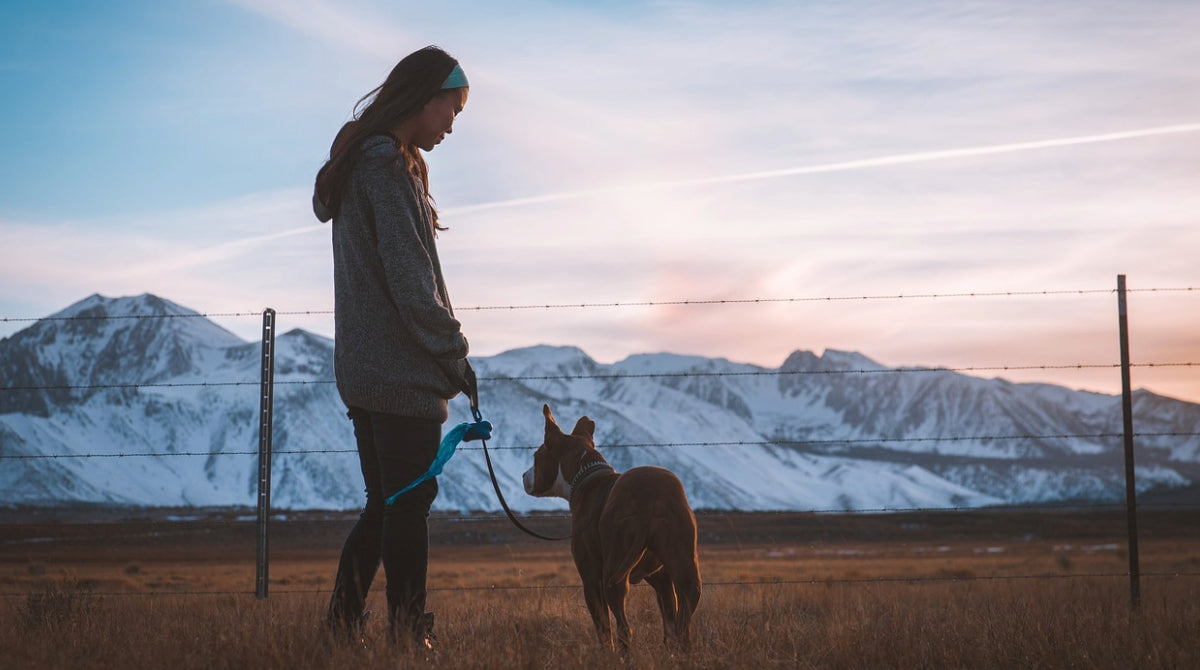
Leash requirement for dogs in Switzerland
by Kim Rüegge
on Nov 08 2024
Get ready for a somewhat heavy-duty, but nonetheless very important blog post. The next few sections will be all about the leash law. We'll explain when you have to put your dog on a leash and when you don't. We'll also cover some of the cantonal regulations. So sit back and read carefully. This way, you can avoid an unnecessary fine and instead invest the money in animal-friendly products from our online shop .
Advantages and disadvantages of a leash requirement:
The leash requirement for dogs, which exists in some places in Switzerland, has both advantages and disadvantages that affect both you as a dog owner and society. Here's an overview:
Advantages of the leash requirement
Wildlife protection : Especially during the breeding season, the leash requirement protects wild animals and their young from potential disturbance and attacks by unleashed dogs. This helps maintain ecological balance and protect wildlife in their natural environment.
Safety for people and dogs : Requiring dogs to be kept on a leash in busy areas such as city parks, pedestrian zones, or playgrounds contributes to the safety of pedestrians, cyclists, and children. Leashes also help control unexpected encounters between dogs, preventing potential conflicts or injuries.
Promote responsible dog behavior : Leash laws encourage dog owners to better control their dogs and teach them obedience. This contributes to a positive perception of dogs in society and demonstrates that the needs of others are respected.
Avoiding conflicts : Leash laws reduce potential conflicts between dog owners and other people who may be afraid of dogs or bothered by dogs running loose.
Disadvantages of the leash requirement
Restricted movement for dogs : Dogs need space to exercise sufficiently and to be able to pursue their natural instincts to run and play. A leash requirement restricts their freedom of movement and can be stressful, especially for active and large dogs.
Limited socialization : For dogs to socialize, it's important that they can interact freely with other dogs. Leash requirements can make these interactions difficult or restrictive, which can impair the dog's social development.
Psychological stress for dogs : Dogs who are constantly kept on a leash can become stressed or frustrated, especially if they can't exercise. This can lead to behavioral problems because the dog can't release its energy.
Challenges for dog owners : Leash laws require constant attention and patience from dog owners, especially in areas where regulations vary. This can make walking less relaxing and create additional challenges if the dog pulls strongly or is poorly behaved on a leash.
Legal regulations on leash requirements
So let's get to the legal part of this blog post. Don't worry, this isn't going to be a university lecture on the topic of leash laws. Nevertheless, here are a few important points:
There is no uniform, nationwide leash requirement for dogs in Switzerland; regulations vary by canton and municipality. Most cantons have specific regulations, which often vary seasonally or regionally.
Examples of cantonal regulations:
Canton of Bern : There is no general leash requirement. However, dogs must be kept on a leash in certain places, such as school grounds, playgrounds and sports fields, public transportation, train stations, bus stops, pastures with livestock, and in nature reserves where appropriate signage is posted.
Canton of Zurich : From April 1 to July 31, dogs must be kept on a leash in forests and at their edges to protect wild animals during the breeding and nesting season. The edge of the forest is defined as an area within 50 meters of the forest.
Canton of Lucerne : During the main breeding season from April 1 to July 31, dogs must be kept on a leash in forests and on forest edges. In nature reserves and parks, dogs must be kept on a leash year-round.
Canton Glarus : Dogs must be kept on a leash year-round in forests and on their edges. Working dogs are exempt from this rule.
It's important to note that municipal regulations may apply in addition to cantonal regulations. Therefore, you should always check the specific regulations in your region and pay attention to local signage.
Regardless of the leash requirement, as a dog owner you are obligated to keep your dog on a leash in a manner that does not endanger or bother either people or animals. Violations of the leash requirement may be punishable by fines, depending on the canton.
Seasonal and regional differences
In Switzerland, leash regulations vary considerably by canton and municipality. Here are some examples of regional differences:
Forest and forest edge rules: In many cantons, such as Zurich and Lucerne, dogs must be kept on a leash in forests and on forest edges during the breeding and nesting season (usually from April 1 to July 31) to protect wildlife. In Glarus, however, dogs must be kept on a leash year-round in forests and forest edges, while in other cantons, such as Bern, this restriction only applies in specially designated areas.
Nature reserves and parks : Some cantons, such as Lucerne and Zurich, have special regulations for nature reserves and parks, where dogs are often required to be kept on a leash year-round. In urban areas such as Zurich or Geneva, stricter rules often apply to accommodate higher population density and increased pressure on public green spaces.
Special locations and municipal rules : In more urban areas, there are often additional regulations for places like school grounds, playgrounds, and busy pedestrian zones. For example, the canton of Bern has a leash requirement in such specific locations, while more rural cantons have fewer restrictions.
Municipal regulations : In addition to cantonal regulations, many municipalities have their own regulations. These may relate to specific local conditions, such as popular tourist destinations, animal pastures, or heavily frequented hiking trails. Sometimes there are even seasonal off-leash areas for dogs in municipal parks where dogs are not required to be on a leash.
Exceptions for working dogs : In some cantons, such as Glarus, exceptions apply to working dogs (e.g. hunting dogs, guide dogs), which are exempt from the leash requirement while they are working.
Penalties and fines for violations
In Switzerland, penalties and fines for violations of the leash law vary depending on the canton and the severity of the offense. Generally, the following consequences can occur:
Fines : Failure to comply with the leash requirement will usually result in a fine. The amount may vary depending on the canton and the situation. For example, in the canton of Zurich, the fine for walking a dog without a leash in the forest during the breeding and nesting season is 60 francs.
Criminal consequences : If a dog is found off-leash and endangers or injures people or animals, criminal prosecution may be initiated. This can result in heavy fines or, in serious cases, further legal consequences.
Liability for damages : If a dog causes damage without a leash, the owner is liable for the resulting costs. This includes medical treatment for injured persons or animals, as well as property damage.
Imposition of measures : In cases of repeated violations or serious incidents, authorities may take measures such as requiring the dog to be kept on a leash or muzzled. In extreme cases, they may even restrict or prohibit the dog's ownership.
It's important to note that the exact penalties and measures vary depending on cantonal legislation. As a dog owner, you should familiarize yourself with the specific regulations in your canton to avoid violations or potential fines.
Conclusion
Leash law in Switzerland is a topic shaped by cantonal and municipal regulations and strongly depends on regional conditions. It primarily serves to protect people, wildlife, and other dogs, but it presents a challenge for you as a dog owner and your four-legged friends. The advantages of leash law lie in increased safety and respectful interaction, while the disadvantages primarily lie in the restricted freedom of movement and social interaction of dogs. Violations of the leash law can result in fines and other consequences, with penalties varying by canton.
Overall, the leash requirement is a compromise that aims to balance the interests of dog owners, animals, and society. It is therefore important that you, as a dog owner, inform yourself about regional regulations and lead your dogs responsibly. Flexible regulations in many cantons make it possible to meet dogs' needs while respecting the rules.
Tradidog motto: If you keep your dog on a leash when in doubt, the problems will solve themselves.
Here you can also find some of the regulations of the respective cantons:
Canton of Bern:
Canton of Zurich:
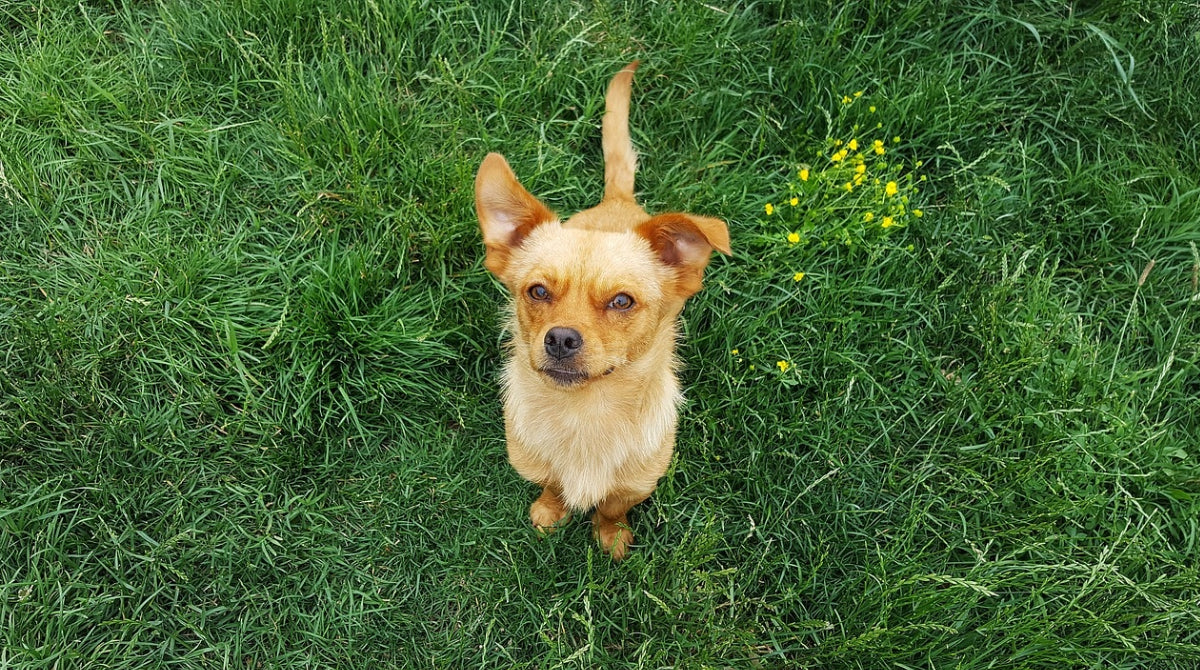
by Kim Rüegge
on Nov 05 2024
The right dog has been purchased, and the home is furnished. But, just like before the birth of a child, a very important question now arises: What name should it be? Are there more common names, or are some names more suitable due to the animal's size? We'll tell you in the following blog post and also share our top list with you.
What are the most popular names for dogs in Switzerland?
In Switzerland, the most popular dog names vary by language region. However, there are some names that are common across the country. According to an analysis by TierWelt, the following names are particularly popular:
Most popular names for female dogs:
Luna : The most common name for female dogs in all language regions of Switzerland.
Kira : The second most common dog name in Switzerland; however, in French-speaking Switzerland, Kira is only in 10th place.
Bella : Ranks third in German-speaking Switzerland; in Ticino it is Mia, and in French-speaking Switzerland it is Nala.
Nala : Fourth in German-speaking Switzerland; third in French-speaking Switzerland.
Amy : Fifth place in German-speaking Switzerland; Lola in Italian-speaking Switzerland, Nina in French-speaking Switzerland.
Most popular names for male dogs:
What exactly is a male dog? A male dog is the name given to a male dog. The term is often used to distinguish a male dog from a female dog, the female counterpart. Male dogs are generally very territorial and can exhibit different behaviors depending on their upbringing and breed.
Rocky : First place among the dogs in German-speaking Switzerland; Lucky triumphs in French-speaking Switzerland, and Jack in Ticino.
Lucky : The name of the lucky dog comes in second place; in Ticino it comes in fourth place.
Baloo : The cuddly bear from The Jungle Book is the third most common name for male dogs; in French-speaking Switzerland it is Snoopy, in Ticino it is Rocky.
Leo : This dog name belongs in fourth place – in every language region.
Max : Last in our ranking; in French-speaking Switzerland, Simba.
We'll show you later in this blog what options you have if you want to make your name design a bit more original.
Are there more common names depending on whether dogs are small or large?
First of all, we find it interesting to know whether there are differences in naming depending on whether the dog is small or large.
There are actually some differences in the choice of names depending on the size of the dog. For large breeds like Great Danes, Labradors, or German Shepherds, owners often opt for powerful or majestic names like "Zeus," "Thor," "Hercules," or "Bella." Large dogs are often associated with strength and protection, which should be reflected in their names.
Small dogs like Chihuahuas, Dachshunds, or Maltese, on the other hand, often get cute or playful names like "Minnie," "Lilly," "Cookie," or "Teddy." These names emphasize the cute, small nature of these dogs and suit their smaller stature. Sometimes, however, dog owners deliberately give their small dogs "bigger" names like "Boss" or "Goliath" – this creates a humorous contrast.
Overall, there are certainly tendencies in the choice of name depending on the size of the dog, but in the end, it is the owner's personal taste that counts.
Where do I find inspiration when I have no ideas at all?
Sometimes it's difficult to find a suitable name for your new dog. Fortunately, there are many sources of inspiration that can help you choose the right name. Here are some tips:
Online name generators : There are numerous websites that offer name suggestions specifically for dogs. These generators are often sorted by breed, gender, or specific characteristics and can help you get started. Some examples include the following: https://www.rover.com/de/blog/rovers-hundenamen-generator/ or https://thestoryshack.com/de/generatoren/hundenamen-generator/
Dog forums and social media : In dedicated dog communities or on social media platforms like Instagram and Pinterest, dog owners regularly share their pets' names. A quick look at other dogs' profiles can provide inspiration and show which names are currently trending.
Pop culture : Names from films, TV series, books, or the music scene are often popular sources of inspiration. From "Simba" from "The Lion King" to "Snoopy" or "Hachiko" – there are many characters whose names dog owners like to adopt. So why not Forrest Gump? Then he'll definitely enjoy moving around. :-)
The dog's character and appearance : Sometimes it can be helpful to observe the dog for a while. What characteristics stand out? Is it particularly playful, brave, or calm? The coat color or special characteristics can also provide ideas—for example, a black and white dog could be named "Domino."
Meaning and origin : Those who prefer something more personal can choose dog names from other languages or with specific meanings. Names from Japanese, Greek, or even Nordic languages are becoming increasingly popular because they sound unique and often have deeper meanings.
Conclusion
Whether classic, humorous, or exotic, choosing a dog name is a very personal decision that should be fun. The various sources of inspiration provide a good basis for finding the perfect name for your new four-legged friend.
Tradidog motto: No matter what his name is, train him properly, so he doesn't bite!
PS: We've launched a survey among the Tradidog team. Our employees would choose the following names for their next dog:
Kumo – A Japanese name meaning “cloud,” perfect for a fluffy, dreamy dog
Floyd – A name with a cool, rock flair, suitable for a relaxed, charismatic dog.
Niko – Short and sweet, with an international touch; ideal for a loyal and active dog.
Soleil – French for “sun”; perfect for a dog who always spreads good cheer.
Arlo – A modern and gentle name that suits many breeds.
Paco – A Spanish name with a charming sound, ideal for a small or particularly funny dog.
